Arlene Stafford-Wilson's Blog, page 25
November 4, 2022
Inge-Va Inderwick Estate
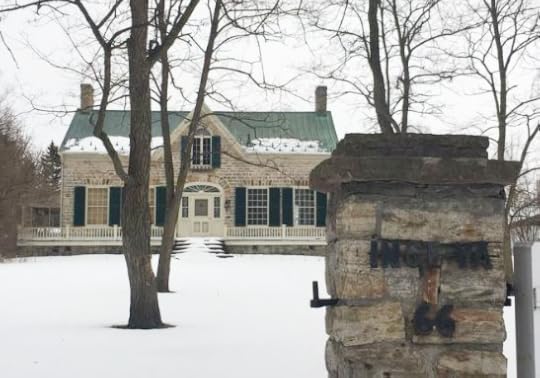
Inge-Va as it appeared in 2018
Inge-Va
Inderwick Estate
At 66 Craig St., in Perth, ON, Built in 1824, of local sandstone.
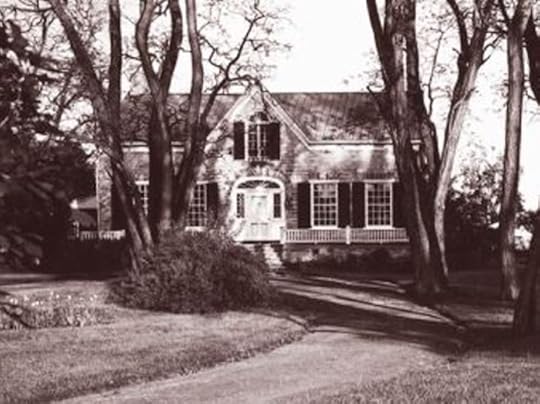
Who were the Owners?
HARRIS family

1824-1839 – Reverend Michael Harris, came to Perth from Dublin, Ireland, in 1819, the first Anglican minister in the district. He was married to Mary Elizabeth Fanning on September 21, 1819. Mary was the daughter of John Fanning and Sarah Wilson. On November 16, 1822, St. James Anglican Church, Perth, opened for their first service, and in 1824, the elegant stone home at 66 Craig Street was built for their family. Michael and Mary Harris had 11 children, Margaret, Mary, Clifton, Caroline, Harriet, Jane, Emma, John, Robert, Dora, and Michael.
In 1839 the house was sold to Perth lawyer, Thomas Radenhurst.
RADENHURST family
1839-1854 -Thomas Mabon Radenhurst, a prominent lawyer, son of Thomas Radenhurst and Ann Campbell; married his cousin Lucy Edith Ridout, daughter of Thomas Ridout of Toronto, and they had four sons and six daughters. He was elected to the Legislative Assemby for Upper Canada in July 1828, as the representative for Carleton County.
Many of Edith’s Children
Died in the House
“She lost three children to tuberculosis, one to typhoid, and one to drowning.“
Edith Radenhurst, was widowed in 1854, at the age of 42, and continued to live in the house. Between 1855 and 1873 she lost three of her 10 children to tuberculosis, one to typhoid and one to drowning. Mary, died age 33, Frances died age 15, Charles died age 27, Edith died age 30, Thomas died age 11, and Catherine died age 26.
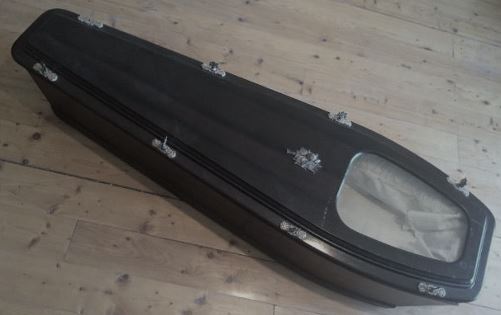
Child’s coffin, of that time
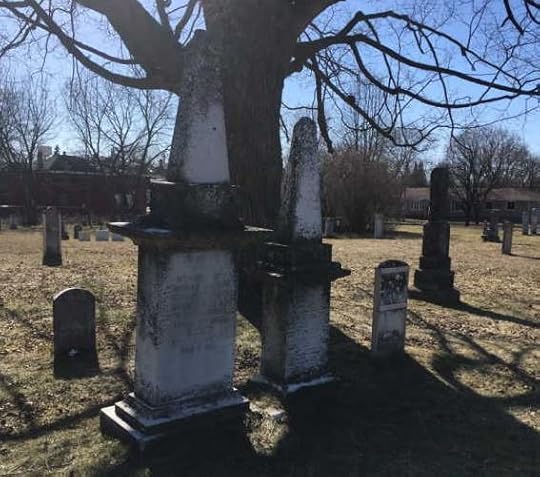
Radenhurst plot, Pioneer Cemetery, Craig Street, Perth, ON
Only four of Edith’s children – George, Anne, William, and Sarah lived into middle age and beyond.
Edith died in 1878, leaving son William, a lawyer, and daughter Annie, to live in the house until 1894. Annie remained single, and moved to Barrie to be closer to her brother, George. William moved his law practice to Toronto.
Archaeologists Discover
Radenhurst Family Dishes
“Thousands of pieces of dishes and kitchenware discovered.”
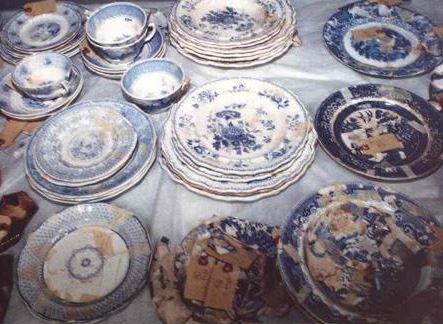
Some of the lovely ornate dishes, glass pieces, and kitchen items were found at Inge-Va
Archaeologists made a remarkable discovery at Inge-Va in 1988. While excavating the site of a small shed which once contained a toilet, they unearthed thousands of pieces of dishes, glasses and kitchenware.
It is believed that Edith Radenhurst had thrown out everything
used to consume meals
because of her children dying of typhoid and tuberculosis.
Last Fatal Duel
Robert Lyon, a close relative of the Radenhurst family was fatally wounded in 1833, in a duel with rival law student John Wilson over the honour of a local teacher. In Perth, it was known infamously as ‘The Last Fatal Duel’. His body lay at the house for the funeral.
In 1894 the estate was sold to the Inderwick family.
INDERWICK family
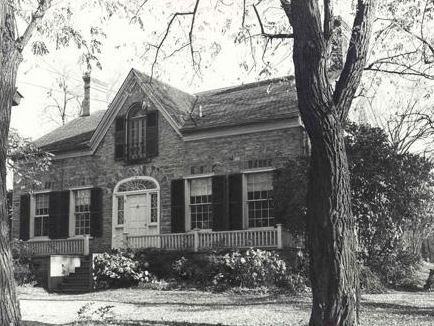
As it appeared in 1923 when the Inderwick family resided there
Ella Leaves Wandering Husband
Brings Children to Perth
1894 – 1989 – Ella Inderwick and her three children: John, Basil, and Cyril, moved into the house in 1894. It was said that she had grown tired of following her wandering husband around the world, in a series of unsuccessful business ventures. Their last stop was her wealthy father-in-law’s tea plantation in Sri Lanka where she often heard the workers in the fields calling out, “Inge-Va”, meaning, ‘Come here’.
“She named the estate Inge-Va
Meaning, “Come Here”
John, the eldest son, moved to England, married Marjorie Handcock, and they had two children – Patrick and Tony. John died in Devon, England at the age of 67. Basil died at the age of 28, fighting with the 17th battalion in WWI, and is buried in England.
Cyril Inderwick, the youngest of the three sons, remained in Perth, joined the Royal Navy, and served in WWI. He lived in the West Indies, and on the west coast of Africa. After WWII, he returned to Perth and married Winnifred ‘Winnie’ Shaw, in 1946, at St. James Anglican church. Winnie was the daughter of Alexander Shaw and Elizabeth Denny. They did not have any children. Cyril became President of the Perth Museum, and was keen on preserving history and specifically heritage buildings. He died at age 67, in 1962.
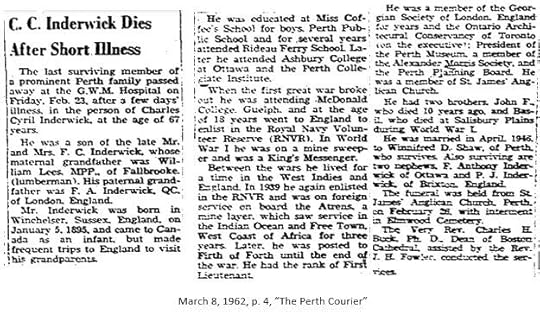
Inge-Va Donated to
Ontario Heritage Trust
Cyril’s wife, Winnifred ‘Winnie’ Shaw Inderwick, local historian and philanthropist, donated the property to the Ontario Heritage Trust in 1974. Through a life-tenancy agreement she remained in the house until her death in 1989.
Ontario Heritage Trust
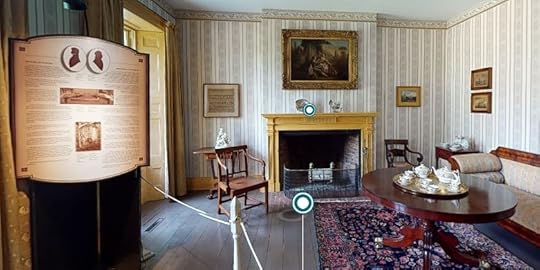
From the Ontario Heritage Trust site – an interactive map of Inge-Va’s rooms
Click on link to take a virtual walking tour through Inge-Va:
https://www.heritagetrust.on.ca/en/properties/inge-va
What Became of Inge-Va?
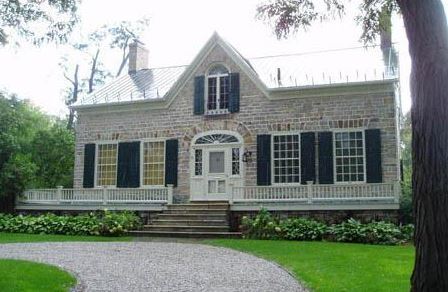
Inge-Va, 66 Craig St., Perth, ON, in 2006
In recent years, the estate appeared to be abandoned, and the grounds overgrown.
In a committee meeting in October 2020, the Perth town council discussed a letter received from a concerned citizen – Lynda Haddon. Haddon stated that Inge-Va was in a dilapidated state.
Together with 16 Perth and district gardening and landscaping volunteers, Haddon maintained and beautified the grounds of Inge-Va in the years between 2004 and 2010. She was also an active member on the house’s Board from 2006 to 2010. The Board attempted to ensure that that there was usually a tenant on site, like the Perth and District Chamber of Commerce, and that the grounds were tidy and buildings were maintained. The Ontario Heritage Trust resumed responsibility for Inge-Va in 2010. Haddon believed that property has gone downhill since then, pointing out that there was no access to the house or the gardens.
Council agreed that Inge-Va appeared to be neglected, and stated that Ontario Heritage Trust is responsible for the property. Council promised to contact Ontario Heritage Trust and said they would investigate further, once they had received a response from Ontario Heritage Trust.
(from the Ottawa Valley News, published Oct. 8, 2020)
In March of 2021, the Perth town council’s voted to sign a one-year agreement with the house’s owner, the Ontario Heritage Trust (OHT), to have volunteers assist in garden restoration at the Craig Street location. The Ontario Heritage Trust promised to provide $2,000 toward the upkeep.
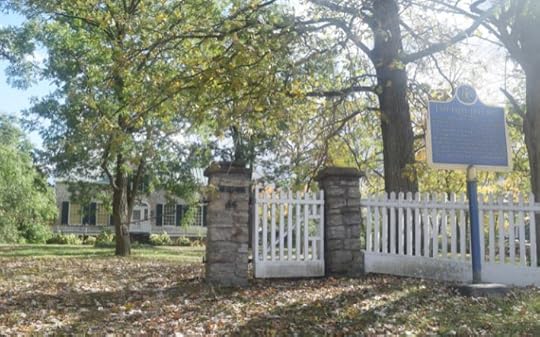
photo: “Inside Ottawa Valley”, “Perth Courier”, Desmond Devoy
Archaeological Treasures
“Inge-Va’s archaeological value is one of its most important characteristics. Excavations carried out from 1987-1994 recovered approximately 50,000 artifacts, 15,000 of which came out of an abandoned privy. This pit contained over 350 china objects and 280 glass objects. Items recovered from the privy include 10 different sets of tableware, 280 bottles, 71 wine glasses, 108 pharmaceutical and toiletry bottles, 16 chamber pots and seven toiletry sets. These items were discarded in an attempt to rid the house of tuberculosis. These objects provide a unique insight into how medical threats were addressed in the latter part of the 19th Century.”
Source: Ontario Heritage Trust Easement Files
(most of these items are being held in Toronto, ON)
Last Fatal Duel
Controversy
Perth Historical Society member, Ron Shaw, has suggested that Inge-Va may not actually be the site of the last fatal duel in the province, as engraved on the plaque, although the body of Robert Lyon is believed to have been carried to Inge-Va for the funeral.
Shaw writes,“an eyewitnesses testified at the Wilson trial, Robert Lyon died where he fell in that North Elmsley Township field,” though Lyon’s body was indeed carried to Inge-Va House, then home of Thomas Mabon Radenhurst (1803-1854), “under whose tutelage Lyon was studying law.”
“(the duel) was fought on the west bank of the Tay River, about 100 yards south of South Street, at a point midway across the width of North Elmsley Township … then the farm of John Ambrose Hume Powell.”
The plaque outside of Inge-Va House on 66 Craig St. states: “Here died the victim of the last fatal duel fought in this province.”
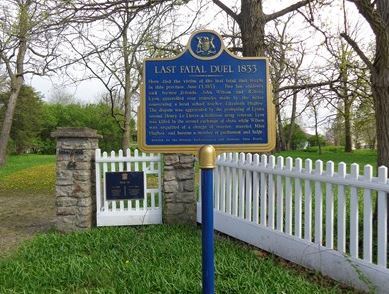
The location of the plaque on the grounds at Inge-Va
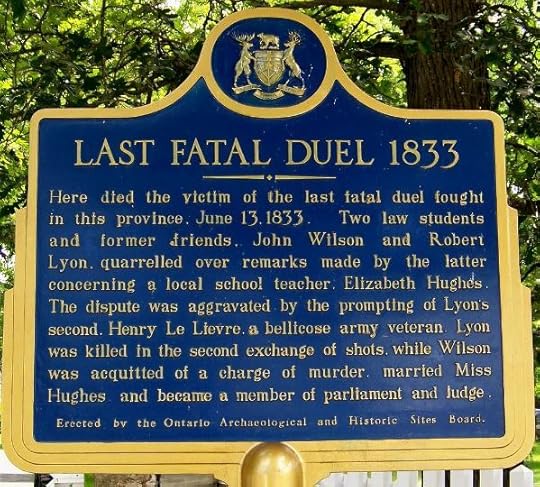
Last Fatal Duel placque at Inge-Va
Source of Last Fatal Duel controversy – ‘The Record News’, Sept. 10, 2021
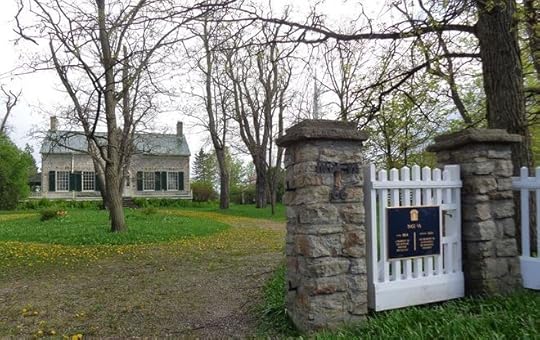
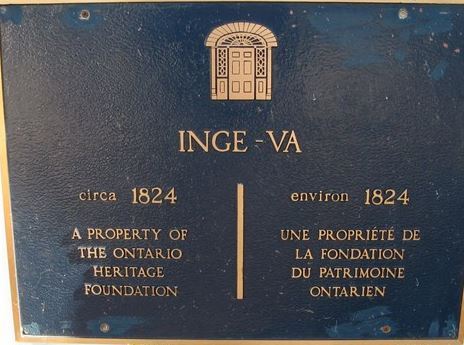
Future of Inge-Va
We can only hope that Inge-Va continues to be valued and treasured by her custodians, and that both the stately house along with the historic grounds are maintained and preserved for future generations.
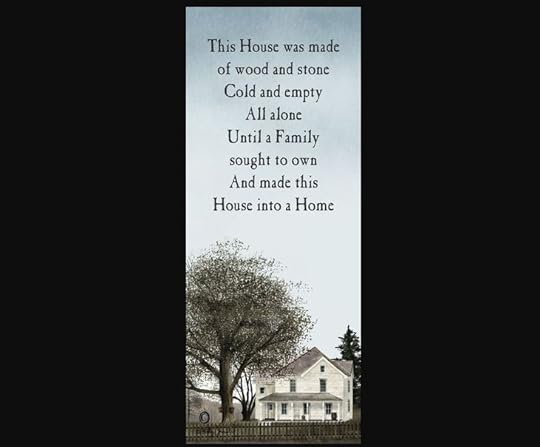
***
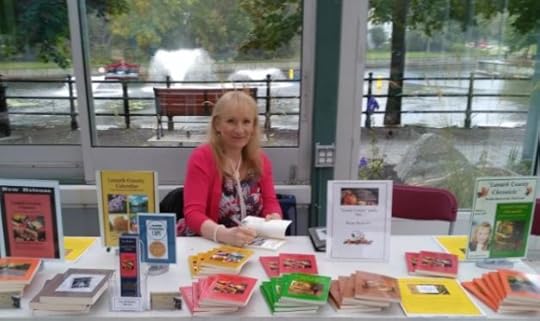
Arlene Stafford-Wilson
Member, Association of Professional Genealogists
Member, Lanark County Genealogical Society
Author of : “Lanark County Christmas”, “Lanark County Comfort”, “Lanark County Collection”, “Lanark County Calling”, “Lanark County Classics”, “Lanark County Connections”, “Lanark County Calendar”, “Lanark County Chronicle”, “Lanark County Kid”, & “Recipes & Recollections”
available at local stores or email: lanarkcountybooks@gmail.com
November 3, 2022
White Church, Drummond Township
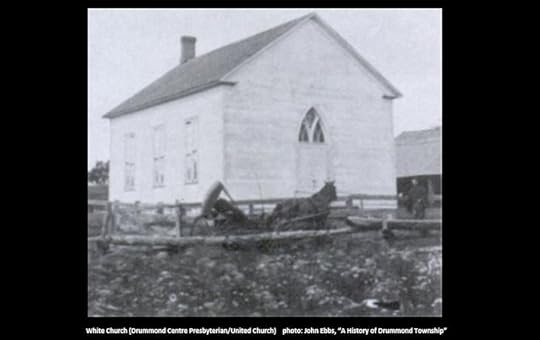
Drummond Centre Church
(also known as White Church)
With transportation being so quick and easy in the modern world it’s difficult for us to imagine that the early pioneer settlers often had to walk from place to place, as not everyone was fortunate enough to own a horse and buggy. They walked to obtain dry goods for cooking and baking, they walked from farm to farm for social events, birthday celebrations, and to visit with neighbours. They also walked to the closest church so they could carry on with the religious practices and beliefs that they brought with them from the old country.
There was a growing group of mostly Scottish, mostly Presbyterian pioneers who had settled in the Drummond Centre area, and in the early days, many of this hardy lot had to walk to Perth to attend church at Knox Presbyterian Church. While walking to Perth was not as much of a difficulty for the younger and healthier members of the community, it was not the case for the elderly, or those who were in the later stages of expecting a child, or for anyone for whatever reason was not physically capable of walking that far. Some of the more prosperous farmers went to Perth on horseback, and a smaller number, more affluent, used horse and buggy, or horse and cutter in the winter.
Duncan McLaren
Duncan McLaren, a respected member of the Presbyterian community, and an Elder at Knox Church, in Perth, was chosen by members of the congregation from Drummond Centre, to visit the Presbytery in Brockville. They were the body responsible for administering the churches in their region. His request was for permission for the people in Drummond Centre to be able to establish a branch of the Presbyterian Church right in their own community.
First Service in 1881
While two mission ‘fields’ were granted in 1877, one at Balderson, and one at Drummond Centre, it was not until 1881 that the new Drummond Centre Presbyterian Church was built and opened. The church was built on the East half of Lot 17, on Concession 8, of Drummond Township. James Stewart sold a quarter acre of land to the church for the sum of one dollar. The deed was signed by Adam Armstrong, James Shaw, and Henry McDonald.
Anniversary Services were held in the fall of 1920:
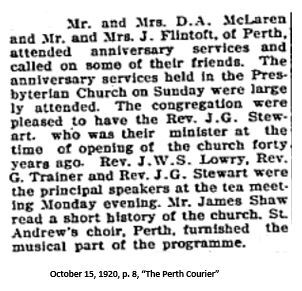
Drummond Centre
United Church
In 1925, with the amalgamation of some of the Presbyterian, Methodist, and United Churches, the Drummond Centre Presbyterian Church became part of the United Church of Canada.
50th Anniversary
On October 26th, 1931, Drummond Centre United Church celebrated their 50th anniversary. An article from “The Perth Courier” provides details of the event, and gives the reader an insight into those times, so long ago:

(transcribed from “The Perth Courier”, October 30, 1931, p. 1)
“This important and most unique event in connection with the Drummond Centre United Church was solemnized and duly celebrated upon Sabbath, October 26th, 1931. Special anniversary services were held morning and evening, the speaker for the day being the minister of the church, rev. Thomas McNaught, B.D., of Balderson. The church was filled to an overflowing capacity at both services, as many former members were present and friends from neighboring communities. Beautiful fall weather prevailed.
“The church was filled to an overflowing capacity at both services, as many former members were present and friends from neighboring communities. Beautiful fall weather prevailed.”
In the morning the service of Praise was in charge of members from St. Andrew’s Presbyterian Church choir, Perth, consisting of aquartetto, Messrs. Dodds, Steele, Howie, and Kerr. Mrs. Kerr presided at the organ. They were assisted by members from the Balderson and Prestonvale choir. Mr. Fred Steele sang a most appropriate solo, ‘Building for Eternity’ which was listened to not only with a sense of joy but of spiritual profit. Then the quartette rendered in a most soul stirring manner that beautiful piece entitled, ‘Jesus, Savior, Pilot Me’. Rev. Mr. McNaught spoke from the text found in 1st Cor. 4:18 and in the words of this text and throughout his sermon he sought not only to show the vast different between the temperal and the spiritual – the transient and the eternal but urged upon his hearers to build upon the eternal verities of the Eternal God and His eternal truth and not to forget the spiritual welfare of their inner and higher life that man cannot live by bread alone but by every word that proceeded out of the mouth of God.
“Mrs. Kerr presided at the organ. They were assisted by members from the Balderson and Prestonvale choirs.”
At the close of the service Mr. McNaught in a few well chosen words thanked the friends from Perth who had taken charge of the service of praise and who had brought such inspiring and helpful messages through the medium of service song. He also expressed the congregation’s thanks to the members of the Balderson and Prestonvale choirs who had assisted.
In the evening a still larger congregation was present. The service of Praise was in charge of the Prestonvale choir. This fine choir was out in full strength and was greatly helped by friends from Perth.
This splended choir led the congregation in its singing a solo, ‘When I Survey the Wondrous Cross’, sung by Mr. Rodney. All listened to it with deep appreciation and a feeling that it brought a wonderful message to all the worshippers assembled. Then a quartette was rendered by Messrs. Reid, McLaren, Rodney and Couch, the selection being, ‘Rock of Ages’, and later the entire choir sang an anthem conveying the old Gospel message in sacred song. At the close of the evening service Mr. McNaughton thanked the Prestonvale choir and organist and the friends from Perth who had assisted them in the name of the congregation assuring them of their sincere thanks and appreciation.
“Before closing the evening service he asked all present to stand who were present fifty years ago at the opening and dedication of the church. Only seven were present who witnessed the opening and dedication of the church.”
Mr. McNaught’s message was entitled, “The Call of Christ”, basing his sermon upon Christ’s words, ‘Follow Me’, recorded in St. Matthew 4:19. His message was a call for all to hear Christ’s call for Christian service and to surrender their all to Him. Before closing the evening service he asked all present to stand who were present fifty years ago at the opening and dedication of the church. Only seven were present who witnessed the opening and dedication of the church.”
“On Monday evening a social time was spent together in the Orange Hall.”
(the L.O.L. # 7 Orange Lodge, one of the earliest established in the country, was located near the church)
“On Monday evening a social time was spent together in the Orange Hall, the hall being put at the disposal of the Church by the local Orangemen for the evening gratuitously which was greatly appreciated by the congregation. There was a large turnout and a fine mixed program was gone through and listened to with much enjoyment and also profit. Some young people from Carleton Place put on very effectively a pantomime entitled, ‘The Lamp Went Out’. Miss Anderson sang beautifully a solo while Miss Brunton of Balderson was the elocutionist of the evening and was heard several times through the evening with great delight to all.
The school children of Drummond Centre under the leadership of Mr. Devy of Perth, put on several numbers which were greatly enjoyed. Then a beautiful drill was gone through in a faultless manner by the girls of the school under the guidance of their teacher Mrs. Horrocks.
“After this, refreshments were served and an enjoyable social time was spent by all.”
The speeches for the evening were three – Rev. Mr. Livesay, returned missionary from Korea brought a wonderful message telling in vivid language the work of the Church in Korea. He was followed by Rev. Dr. James Semple of Smiths Falls and as chairman of the Renfrew Presbytery brought the Presbytery’s greetings to the congregation upon this the occasion of their golden jubilee. He too brought a wonderful message urging upon the congregation to ever emphasize the essential things of our Christian faith. He referred to the very fine friendship existing between him and their pastor, Mr. McNaught – that not only were they college chums but had graduated the same year. Inspector T.C. Smith, M.A. was also heard in a short address of congratulations to minister and people and a few words of Christian counsel. Mr. McNaught was chairman and welcomed all present. The first part of the evening was brought to a close by the chairman thanking all in the name of the congregation who had assisted in the program and by the entire audience rising and singing the National Anthem. After this, refreshments were served and an enjoyable social time was spent by all.
Church History
Some details of the rich history of the church were also provided in the article from, “The Perth Courier”, dated October 30, 1931:
“A brief history of this congregation might be interesting. Drummond Centre community was largely settled by pioneers from Scotland over 100 years ago – their spiritual interests were not forgotten and they realized the need of God in their lives. The following extract was read and prepared by the late Mr. James Shaw at the 40th Anniversary and taken from a local paper, October 14th, 1920:
“In the pioneer days in Drummond Township many of the earlier settlers had to drive a considerable distance to Knox Church, Perth. As many of these settlers had come from Scotland, a land where the ordinances of divine grace were faithfully attended, the people felt they must have in their own community some visible sign of Jehovah’s presence. To this end Mr. Duncan McLaren, an elder of Knox Church, Perth, was chosen to appeal to the Brockville Presbytery for permission to form a congregation. After some discussion Presbytery granted the request and steps were taken to form a congregation in connection with Balderson, an outshot from St. Andrew’s, Perth.
“As many of these settlers had come from Scotland, a land where the ordinances of divine grace were faithfully attended…”
In 1877, mission fields were formed in the congregations with Mr. J.K. Baillie as the first missionary, who remained among us for two summers. Mr. Baillie was followed by Mr. John Geddes, who labored for a year and a half, after which he returned to Scotland.
The two missions were established as one congregation in the summer of 1880 and called Rev. J.G. Stuart as minister, who was inducted into the charge in October, 1880. His salary was $400 supplemented by $200 from the Mission Board. During his ministry of over nine years he endeared himself to the congregation especially in the Sabbath School and among the young. In December 1889, he resigned, being called to St. Mark’s Church, Toronto.
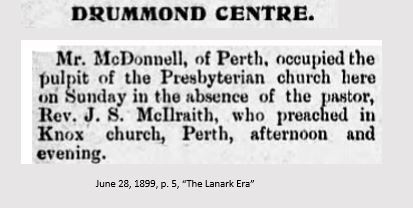
Then a few months afterwards a call was extended to Rev. J.S. McIlraith, of Montreal College and in the spring of 1890 he was inducted. He labored amongst us for almost twenty-one years doing faithful work especially visiting the sick and the aged. He resigned in the summer of 1911 and was followed by Rev. J.G. Greig.
Rev. J.G. Greig was inducted in the autumn of 1911 and ministered to us almost eight years. He too gave us faithful and practical sermons which if we lived out in our daily lives would make us more Christlike in character. In the autumn of 1919 Mr. Greig accepted a call to Valleyfield, Quebec. At the close of his ministry the missionary givings amounted to $1,722.00 and the minister’s stipend to $1,400.00, there having been a gradual increase in the givings from the congregation to the present date. After being several months without a settled minister a call was extended to Rev. G.C. Treanor and accepted trusting that the ministry will be as successful as those who preceded him.
“He too gave us faithful and practical sermons which if we lived out in our daily lives would make us more Christlike in character.”
In the fall of 1922 Mr. Treanor resigned, having accepted a call to Arthur and Goodville in the Saugeen Presbytery.
In March, 1923, a unanimous call was given to Rev. R.A. McRae, B.A., a recent graduate of the Montreal Presbyterian College. He was ordained and inducted in the Balderson Church in March 1923. He did faithful and conscientious work, and resigned in 1927, and is now laboring at Minden, Ontario. During his pastorate the charge passed into the United Church.
In 1925, the Drummond Centre Presbyterian Church became part of the United Church of Canada, and so, was re-named, the Drummond Centre United Church.

(The United Church of Canada was formed 10 June 1925 by the union of some, but not all, of the Presbyterian Churches in Canada, with the Methodist Church, the Congregational Churches of Canada, and the General Council of Local Union Churches.)
“Rev. C.M. Currie, M.A., B.D., then became pastor having received a call and did faithful work until he resigned in the year 1930 in order that he might pursue a post graduate course in New College, Edinburgh, Scotland, for his Ph.D. degree. Before leaving for Scotland he was married to Miss Edith McTavish, of Balderson. Recently, he has been called and accepted same to be assistant minister of Connorgate Church, Edinburgh, Scotland. In the summer of 1930, Rev. Thomas McNaught, B.D., of White Lake, became pastor pursuant to an unanimous call being extended to him and he was inducted on the evening of July 4th, 1930.
“The organizers of the Church in Drummond were: Duncan McLaren, James Shaw, and James Stewart.”
A few items might be interesting re the Drummond Centre Church. The organizers of the Church in Drummond were Messrs. Duncan McLaren, James Shaw, and James Stewart. Mrs. Stewart deeded the land for the church. Rev. Wm. Burns of Knox Church, Perth, conducted the opening services and preached. The first preacher in the church was the late Mr. Adam Young, followed by the late Mr. John Hillis, who was followed by the late Mrs. Wesley Clarke and he in turn was succeeded by Mr. D.A. McLaren and later by Mr. Wm. McFarlane, now of Prestonvale.
The elders now at Drummond are Messrs. Wm. McLaren, Dan Malloch, J.B. Miller and Wilbert Lewis, and the Managers are Messrs. Homer Shaw, James McLaren and John McNaughton.”
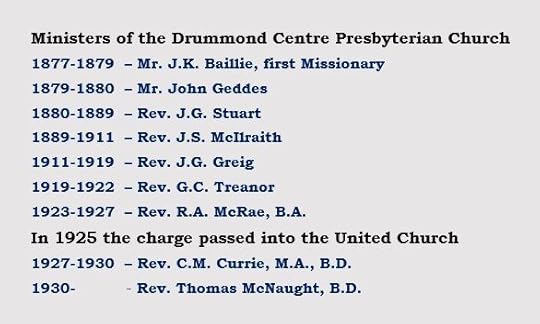
Rev. Thomas McNaught

Minister at Drummond Centre United Church, beginning in 1930
Anniversary Services
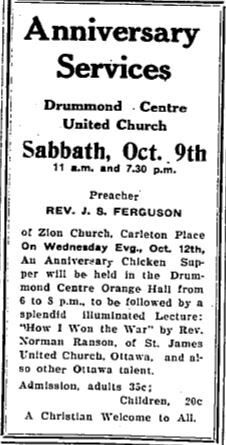
Oct. 7, 1932, p. 5, “The Perth Courier”
Mother’s Day Service
In the spring of 1933, a special Mother’s Day Service was held at Drummond Centre United Church:
“Miss (Mary) Malloch some time ago received a Bible from her pastor for having recited correctly at one sitting the entire 119th Psalm.”
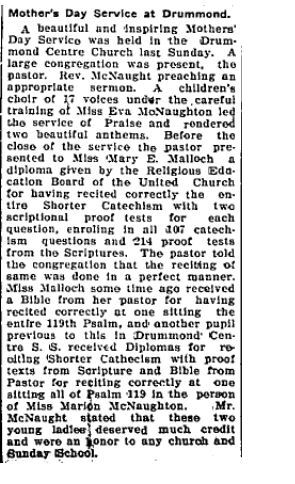
May 19, 1933, p. 1, “The Perth Courier”
Church Closes
The Drummond Centre United Church closed its doors in 1951, and the remaining members of the congregation joined either St. Paul’s United Church, in Perth, ontario, or the United Chuch at Boyd’s Settlement.
Church Sold
After the church closed, the building and land was sold to a Mr. Probert, from Carleton Place, Ontario. Mr. Probert owned the property for 21 years, then sold it in 1971 to Clifford Ebbs, who moved the building a short distance south on Gardiner Road to a building lot.
(This is the house directly across Gardner Rd from the E. corner of the Drummond Center Community Cemetery)
The church was sold to Keith Mordy in 1973, and the building was converted to a duplex.
The Cemetery
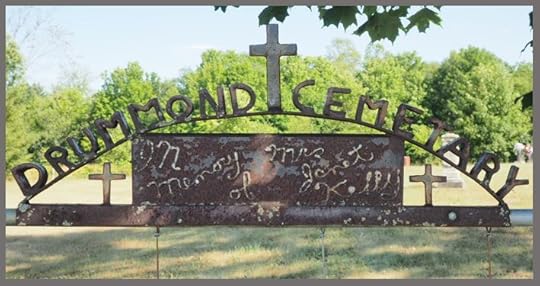
Along with the land donated by James Stewart for the church, James McLaren donated land for a ‘burying ground’, nearby, which is now called the Drummond Centre Community Cemetery.
This cemetery was used as a ‘burying ground’, from as early as the late 1820s or early 1830s. In November 26, 1858, he property was transferred by James and his wife, Christina McLaren, to the Trustees on behalf of the Presbyterian Church of Canada.
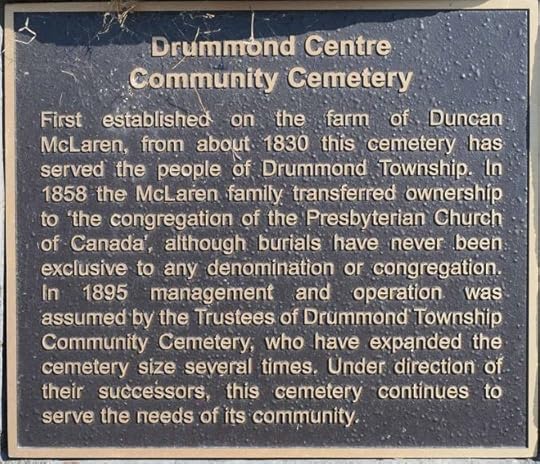
The connection to the Presbyterian Church was severed in May 1895, and it became a “community” cemetery, with the first community trustees being James and his wife, Janet Stewart, John Malloch, and James Shaw.
(Note: descendants of the same families continue to serve as trustees today.)
Surnames in the cemetery:
ALLEN, ARMSTRONG, BARROWMAN, BENEDICT, BEUREGARD, BULLIS, CAMPBELL, CASWELL, CLARK, COOKE, CUNNINGHAM, DEVLIN, FERGUSON, FLINTOFF, FLINTOFT, GREENLEY, HAIG, HALL, HATCH, HORLER, HORRICKS, IRETON, IRVINE, KEYES, KEYS, KIRKHAM, LEWIS, MALLOCH, MCCOY, MCCULLOUGH, MCDONALD, MCEWEN, MCGREGOR, MCLAREN, MCLEAN, MCNAUGHTON, MCPHAIL, MCPHERSON, MORIS, MORRIS, MORROW, MOULTON, OATES, PALMER, POWERS, RICHMOND, ROBERTSON, SCHOOTEN, SHAIL, SHAW, STEEN, STEWART, TYSICK, WHITE, WILLOWS, WOOLSEY, YOUNG, YUILL
Orange Lodge L.O.L. # 7
One of the earliest lodges of the Protestant group, the Orange Order, was built close to the church, and the space was often donated by the Lodge for use by the church members for their clubs, and activities. The land was ‘sold’ to the Loyal Orange Order in 1903, by Nathaniel Caswell for $1.00.
Today
…..And so today, we wonder why the little white church on Gardiner Road closed in 1951? Was it because the community was more mobile, with access to automobiles, and they preferred to attend a larger more stately church, like St. Paul’s United, in Perth? Did the maintenance become too expensive on the small church built so many years before? Could it be that an old church lacked a good heating system for those cold winter days in Eastern Ontario, or adequate cooling on the equally hot and humid dog-days of summer?
There is no longer any sign of the Orange Hall, #7 L.O.L, that served the members of the community in those early days. The members from that old lodge eventually joined another nearby.
The cemetery remains, and the names on the oldest stones tell a story of those early Scottish pioneers who settled in Drummond Centre. In an unbroken chain of loyalty and sense of duty, descendants of those original stewards of the cemetery still maintain it to this day, walking the grounds where their ancestors walked, guarding the memories of the little white church and its people, who came to this pretty community, so long ago.
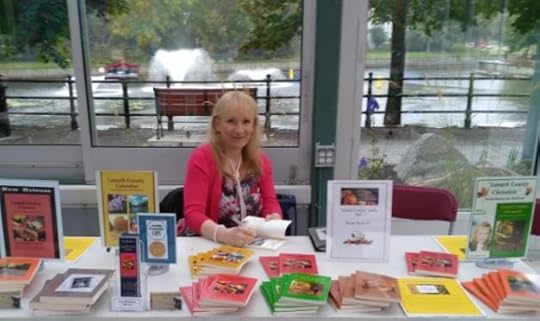
Arlene Stafford-Wilson
Member, Association of Professional Genealogists
Member, Lanark County Genealogical Society
Author of : “Lanark County Christmas”, “Lanark County Comfort”, “Lanark County Collection”, “Lanark County Calling”, “Lanark County Classics”, “Lanark County Connections”, “Lanark County Calendar”, “Lanark County Chronicle”, “Lanark County Kid”, & “Recipes & Recollections”
available at local stores or email: lanarkcountybooks@gmail.com
November 2, 2022
Weather Lore & Sayings
Weather – It’s one of our favourite topics of conversation, and has an effect on all of us, every day of the year. It dictates the way we dress, what we carry with us, and whether we schedule an activity or not. As Canadians we can’t wait for those first signs of spring and the melting snow, then in the summer we plan important family gatherings when the weather is warm and sunny, later, the fall ushers in a cooler more colourful change, and then there are the challenges of getting around during the winters months.

Farmers are more concerned with the weather, and discuss it more often, than any group of people I’ve met, and this becomes abundantly clear when you spend your youth in a rural area. Will there be enough rain, or too much rain, will a drought destroy hard work and money invested, will it be dry enough to harvest? These things are a constant source of worry for a farmer, and have a huge impact on whether it will be a financially successful season, or a fiscal disaster.
Our Dad had many of his own sayings about weather that he shared from time to time. He grew up on a farm in Drummond Township in the 1920s, then later did his own farming on the Third Line of Bathurst. Having spent so much of his life out in the country, he had also participated in countless conversations on the subject, and maybe had picked up a few weather sayings along the way.
Red Sky?
“Red sky at night, sailor’s delight,
Red sky at morning, sailors take warning”
Is it true that a bright pink sky at sunset means fair weather the next day?

Dew on the Grass
“When the dew is on the grass,
Rain will never come to pass.
When grass is dry at morning light,
Look for rain before the night.”

Circle Around the Moon
“If a circle forms ‘round the moon,‘Twill rain soon.”

Leaves Turn Their Backs
“When leaves turn their back
‘tis a sign it’s going to rain.”

Birds Fly Low
“If birds fly low
expect rain and wind below.”
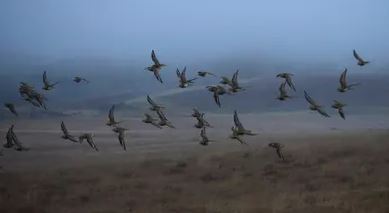
Moon Colours
“Pale moon rains; Red moon blows.”
White moon neither rains or snows.”

Wind Direction
“When the wind is in the east, it’s good for neither man nor beast.
When the wind is in the north, the old folk should not venture forth.
When the wind is in the south, it blows the bait in the fishes’ mouth.
When the wind is in the west, it is of all the winds the best.”
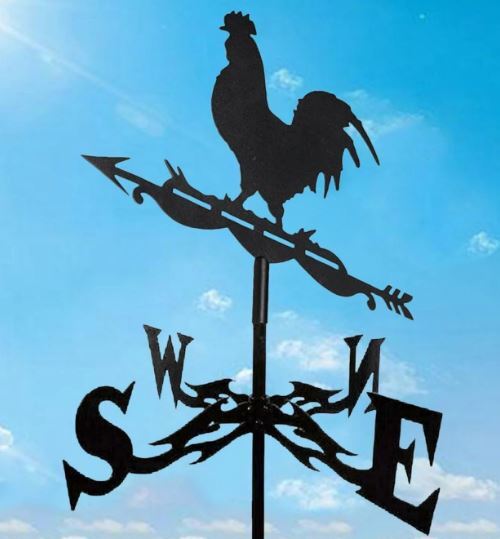
Rain Before Seven
“Rain before seven,
clear before eleven.”
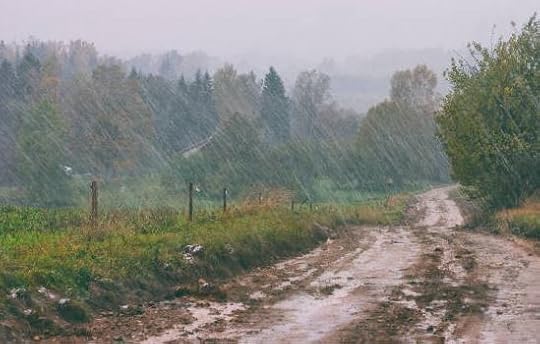
Quick Storm
“The sharper the blast
the sooner ‘tis past.”

Sore Joints
“When your joints begin to ache,
rainy weather is at stake.”

Barometers
“When the glass falls low, prepare for a blow;
when the glass is high, let your kites fly.”
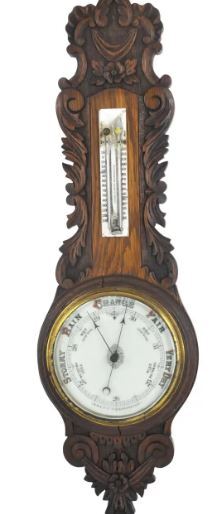
Bright Moon
“Clear Moon,
frost soon.”

Clouds
“When clouds appear like towers,
the Earth is refreshed by frequent showers.”

Sun Dog
“A Sun Dog at play
Rain is on the way.”

Cows
A cow with its tail to the west, makes weather the best;
a cow with its tail to the east, makes weather the least.”

Bee Hives
“When the bees crowd out of their hive, the weather makes it good to be alive.
When the bees crowd into their hive again, it is a sign of thunder and of rain.”

Flies
“If a fly lands on your nose, swat it till it goes.
If the fly then lands again, it will bring back heavy rain.”

Candlemas (Feb. 2nd)
“If Candlemas Day, be bright and gay, saddle your horse, and go buy some hay
If Candlemas Day be cloudy and rough, stay by the fire, you’ll have enough.”
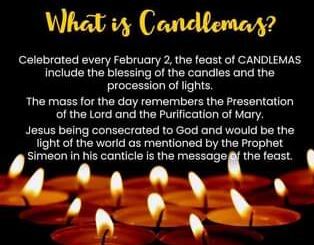
Roosters Crowing
“If the rooster goes crowing to bed;
He’ll certainly rise with a watery head.”

Ladybugs
“When Ladybugs swarm,
Expect a day that’s warm.”

Cat’s Ears
“When kitty washes behind her ears,
we’ll soon be tasting heavens tears.”

Frogs
“Frogs will sing before the rain,
but in the sun they’re quiet again.”

Stars
“When the stars being to huddle,
the earth will soon become a puddle.”

Leaves
“If autumn leaves wither and hang on the boughs,
it foretells a frosty winter and much snow.“

Hornet’s Nest
“See how high the hornet’s nest;
‘Twill tell how high the snow will rest.”

Snow
“If snow begins at mid-day
Expect a foot of it to lay.”
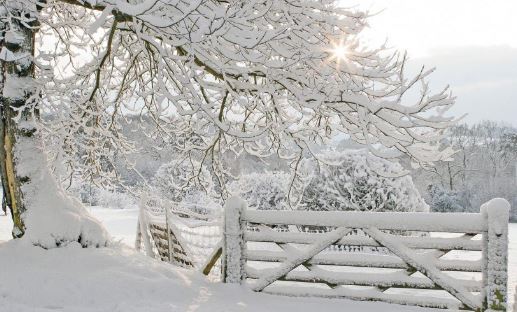
Corn Husks
“When the corn husks are thick ‘tis very clear,
The winter will be long and the weather severe.”

Onion Skins
“Onion skins very thin,
Mild winter coming in;
Onion skins thick and tough,
Coming winter cold and rough.”

Cicadas/Heat-Bugs
“If you hear the first song of the Cicadas today,
Then frost is just six weeks away.“
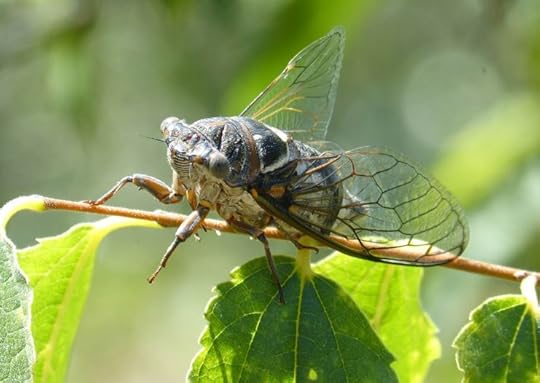
Dark Clouds
“When clouds look like black smoke
a wise man will put on his cloak.“

Weather Lore, Sayings, and Rhymes:
There are many sayings and lore related to the weather that have evolved over the years, some of them passed down through the generations, and some have been around so long that we have no idea of their origins. What we do know is that the reason these old sayings, old wives-tales, and expressions have been around this long is because many of them are true.
Long before there were weather apps for your phone, or Doppler radar, or the local forecasts, our ancestors were busy observing their natural surroundings. Through their observations, they noticed that animal behavior, clouds, and other elements of nature gave them some important clues about the weather to come.
Their weather folklore was often in the form of ‘sayings’, simple rhymes and anecdotes, and these were passed down from generation to generation.
Many of this old weather lore has been passed down through our families, and remains with us today.
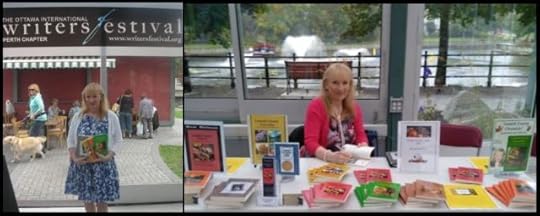
Arlene Stafford-Wilson
Member, Association of Professional Genealogists
Member, Lanark County Genealogical Society
Author of 10 books: “Lanark County Christmas”, “Lanark County Comfort”, “Lanark County Collection”, “Lanark County Calling”, “Lanark County Classics”, “Lanark County Connections”, “Lanark County Calendar”, “Lanark County Chronicle”, “Lanark County Kid”, & “Recipes & Recollections”
available at local stores or email: lanarkcountybooks@gmail.com
October 29, 2022
Mystery of St. James Church, Hood’s

St. James United Church & Cemetery – Lot 16, Con. 2, Dalhousie Twp., at Hood, Lanark County, Ontario

“Who owns the property now?”

Oct. 28, 1971
“Early this year, after much consideration and discussion among the parishioners, the church was tendered for sale. The response passed all expectations, and, on September 10, 1971, the old pioneer church was sold to Mr. and Mrs. Eric Davis of Seattle, Washington, who plan to remodel it into a permanent home.”
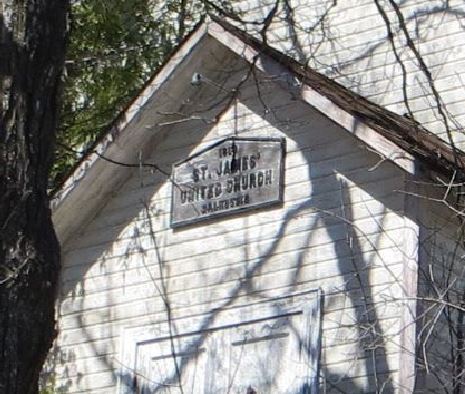
Sign on St. James’ United Church
An article about St. James Church was dated October 28, 1971, written over 50 years ago, by an anonymous author, and published in “The Perth Courier”. According to the author, the church had just been sold, with the promise that it would be remodeled and loved once again, by its new owners. For reasons unknown, the building was never touched, and it stands today, abandoned, with the original ‘St James’ sign attached, looking a little worse for the wear, the fact that it’s still upright, a tribute to the pioneer builders who constructed this church in 1860.
Area known as Hood, or Hood’s Corners
Hood, named for the Hood family who settled there, and most likely for William Hood, educated in the University of Glasgow, the teacher at Hood’s Corners School. William was the son of James Hood, who came from Scotland along with others, on the ship, “Prompt”.
The very earliest settlers to the area came in the fall of 1820, Scotsmen from Glasgow and Paisley. James Blair, John McLellan, John McNangle, Neil Campbell, Donald McPhee, James Martin, William Barrett, Charles Bailie, James Watson, George Brown, Thomas Easton, George Easton, Edward Conroy, Peter Shields, John Donald, John Duncan, Andrew Park, James Park, John Todd, William Jack, James Hood, Alex Watt, Robert Forest, George Richmond, and John Duncan were among the first to arrive.
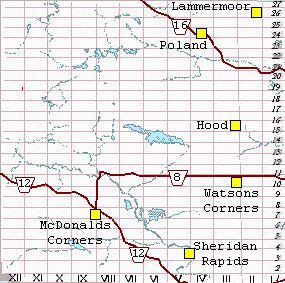
St. James Church
The article from “The Perth Courier” (author unknown) Oct. 28, 1971
“The little white church on the top of the hill at Hoods, two miles north of Watson’s Corners, is now awaiting a new tenant.
The St. James’ United Church, which was built in 1859, holds many memories for the older inhabitants of the area. In the early days, people walked from Elphin, McDonald’s Corners and other communities to worship. Also, stables were provided for the convenience of those who came by horse and buggy.
The church, guarded by three large maple trees, is enclosed by wire strand fencing. An unusual aspect of this is that the cedar posts are ornamented, and the wire is threaded through the posts horizontally. On the top of each vertical wire is a small metal maple leaf. Early this year, after much consideration and discussion among the parishioners, the church was tendered for sale. The response passed all expectations, and, on September 10, 1971, the old pioneer church was sold to Mr. and Mrs. Eric Davis of Seattle, Washington, who plan to remodel it into a permanent home.
On Thanksgiving Day, October 11, an auction sale was held of the church furnishings which drew a large crowd of people. Some were bargain hunters while others came to buy a memento of their former place of worship.
Steeped in history, the church had many ministers, the first being the Rev. John Robb, who came from the Dutch Reformed Church in the United States. He was inducted on May 29, 1846, and services were first held in the old St. Andrew’s Hall. The Rev. Robb died on May 27, 1851, and was buried on the Hall property, but it was not until 1930 that the grave was marked with a headstone. The Rev. Robb donated a silver communion urn and goblets inscribed, “Scotch Church, Dalhousie, Canada West, Rev. J. Robb.” These were in use at St. James’ Church for many years and now will be placed in the museum.
Following the death of Rev. Robb, Dalhousie came under the supervision of the Lanark ministers. Early in 1859, Middleville and Dalhousie became one field, under the direct ministry of Rev. William Clarke. It was during his ministry that St. James’ Church was built. He inspired the congregation to have a place of worship entirely dedicated for this purpose. The walls were raised in the Fall of 1859, but it was not used for worship until 1860.
The building was erected without financial assistance from outside sources. The work was done as money became available from the congregation and the church was used before the interior was completed.
The first seats were hand-made, being square-backed and not made for comfort. They were placed down each side of the church, making one center aisle. Because of the long length o the seats, the offering was collected by means of a velvet pouch fastened to the end of a long rod.
It seems as if the year 1894 was a prosperous one as several projects were accomplished. The walls were plastered and painted a pale green, new pews were installed, and a new pulpit added, along with chairs and a carpet. The Session House was built in 1862 and a woodshed in 1895. The pine log walls of the church were clapboarded in 1896 and the windows were frosted in 1897.
From 1860 until the first organ was installed in 1895 there was a special box-like pew before the pulpit. Here sat the Precentor, who pitched the key for singing, using a tuning fork. Mr. David Easton performed this duty for many years.
Since the land for the church site was donated by James Reid, it was his wish that the church be named, “St. James”. Mr. Reid kept a diary in which many of the facts of the pioneer history of the community were recorded.
During the early years, the Bible Society made annual visits to St. James’ Church and the representative would stay overnight with Mr. Reid. It was also recorded that the trees in front of the church were planted by William Penman and David Forbes.
The Synod Minutes of 1860 reveal that the Rev. William Clarke was paid $94. semi-annually. This money came from Middleville, Dalhousie and Lanark. His last service was held on February 26th, 1865. He was known as a very capable speaker and made a great contribution to this area.
During Rev. McConnells’ ministry, the first manse at Watson’s Corners was built in 1893, and the next year the Zion Church was built at Watson’s Corners.
During Rev. McLean’s ministry in 1908, the Manse was burned to the ground on August 20, but was rebuilt immediately after the fire.
It was during Mr. Clark’s ministry in January 1965 that St. James’ Church amalgamated with Zion Church at Watson’s Corners, when services were held at each church on alternate Sundays.
In June 1965, St. James’ Church was closed, along with several other churches in the district. Since then, the people of St. James’ congregation have been known as St. Andrew’s of Central Lanark Charge, and they attend church at Watson’s Corners.
During the past six years, only two worship services have been held in the pioneer church. One was on August 13, 1967, when the Machan reunion held a special centennial service with the Rev. L. M. Somerville, of the Machan clan, as speaker. The last service was held on September 26, 1971, to honour the forefathers of the congregation with the Rev. E.C. Brown, Minister of St. Andrew’s officiating. He gave an inspiring message that was appropriate for the historical occasion. During the service, the choir sang the anthem “The Beautiful Garden of Prayer”, while Mr. Harry Stead gave a sole, “Others”
In the past 105 years, St. James’ Church was used as a sanctuary. Hundreds of worshipers from miles around received spiritual blessings and encouragement to carry on their daily tasks. Many people will treasure in their hearts the many happy memories of hours spent in fellowship and spiritual help received at St. James’ Church.”
The ministers of St. James’ Church:
1860-1864 Rev. William Clarke
1865-1871 Rev. Donald J. McLean
1872-1879 Rev. Wm. Cochrane
1881-1893 Rev. Joseph Andrews
1893-1895 Rev. James McConnells
1896-1903 Rev. James Leitch
1903-1909 Rev. J.R. Miller
1906-1909 Rev. J.A. McLean
1910-1916 Rev William Ferguson
1916-1920 Rev. J.R. Wilson
1920-1928 Rev. J.T. Caswell
1928-1931 Rev. Henry Scott (for a few months in 1931 Rev. J.H. McLaren)
1931-1937 Rev. L.N. Beckstead
1937-1939 Rev. Harry Peters
1939-1942 Rev. R.A. Cameron
1942-1943 Mr. H.C. Mercer
1943-1956 Rev. D.J. Campbell
1956-1962 Rev. Fred Wakeling
1962-1965 Mr. L.V. Clark
Property Sales History: (West half of Lot 16, Concession 2, Dalhousie Township, Lanark County)
June 27, 1844 – the Crown transfers 100 acres to the Canada Company
Feb. 6, 1857 – James Reid purchases 100 acres, rear (or west half) for 75 pounds
Mar. 24, 1859 – James Reid sells (donates) to the Presbyterian Church Trustees 22,500 square feet for the sum of $2.00
Dec. 2, 1971 – Lorne Pretty and Keith McNicol (Chairman and Secretary of the Trustees of St. Andrew’s Congregation of Central Lanark Renfrew Presbytery, of the United Church of Canada) – sell the church property 150 ft. by 150 ft. (22,500 square feet)
to Eric Davis and Chloe Davis, for the sum of $2,950.
(this was the last listed transaction in the historical records)
Source: the historical records of the Ontario Land Registry, (Lanark County LRO 27), Dalhousie Township, Concessions 1-3, p.130
Abandoned at Hood’s
No one seems to know what happened to the owners of the property, or why the old church wasn’t remodeled into a family home, as was the original intention, discussed with the parishioners of St. James, over 50 years ago.
The Davis family was from Seattle, Washington. Were they vacationing in the area when they decided to purchase the church? Did they ever return to Hood’s?
Whatever the reason this historic pioneer church was never remodeled by the owners remains a 50-year-old mystery.
Sadly, this abandoned house of worship with its traditional-style interior are examples of early architecture by the Scottish pioneers. Part of a proud community, this building witnessed many baptisms, marriages, and funerals of the community’s early Scottish settlers, a refuge and sanctuary for the new emigrants, as they forged their way in the new land.
Perhaps we’ll never know the real reasons that St. James Church was abandoned by its owners.
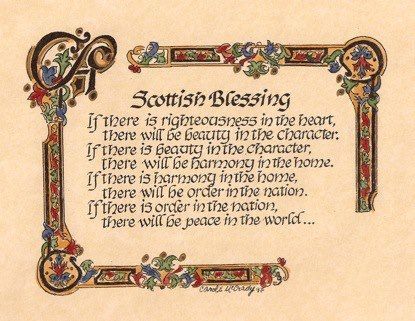
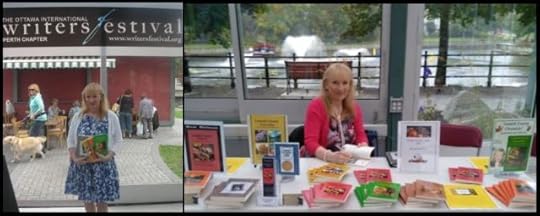
Arlene Stafford-Wilson
Member, Association of Professional Genealogists
Member, Lanark County Genealogical Society
Author of 10 books: “Lanark County Christmas”, “Lanark County Comfort”, “Lanark County Collection”, “Lanark County Calling”, “Lanark County Classics”, “Lanark County Connections”, “Lanark County Calendar”, “Lanark County Chronicle”, “Lanark County Kid”, & “Recipes & Recollections”
available at local stores or email: lanarkcountybooks@gmail.com
October 27, 2022
Ottawa Valley Disaster
On a cold and stormy November night, in 1912, the “Mayflower” sank into the frigid waters near Barry’s Bay. There were 12 people aboard, including crew members, and the only survivors were three travelling salesmen from Ottawa. The brave young salesmen clung onto a wooden coffin, part of the ship’s cargo, which stayed afloat, and they made it to a small island, and were rescued the following day. The other eight souls onboard perished.
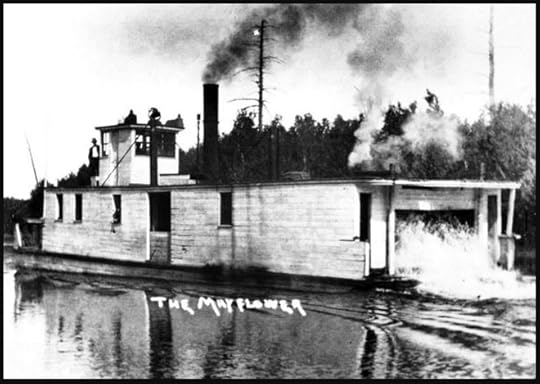
The Ship
The “Mayflower” was built in 1904, from oak, hemlock, and local white pine, on the shore, beside the Hudson Hotel in Combermere, Ontario, by Napoleon Tessier, of Hull, Quebec, for two brothers, John Charles Hudson and Henry Edwin Hudson. She had a length of 77′, a breadth of 18′, a depth of 4′ and height of 20′, and was powered by two steam engines. The “Mayflower” was nearly a flat-bottom boat, designed for navigating the shallow waters on the Madawaska River. A single rear paddle wheel was set into the stern and had twelve paddles. By 1912, the eight year old boat had not been well maintained, was not seaworthy, and was not certified for safe operation.
The “Mayflower” was used for transporting freight, mail, and also offered a limited passenger service between Barry’s Bay and Combermere, also Palmer Rapids, on the Madawaska River.
The crew of three included: Owner and Captain John Hudson, the Pilot and Wheelsman – Aaron Parcher, and the young Fireman and Engineer, Tom Delaney.
Because of very low level running-lights this ship was not designed to be on the water after dark. What was supposed to be the final run of the season took place earlier that same day. The ill-fated voyage would never have left the harbour if it wasn’t for the local Radcliffe Township Councillor, William Boehme, who persuaded Captain Hudson to make one final trip that evening to transport the corpse and coffin of a relative – John ‘Herman’ Brown, who had died five days earlier in Saskachewan, and had arrived that day by rail.
The 12 People Onboard
On Tuesday evening, November 12, at 7:00 p.m., the Mayflower left the harbour at Barry’s Bay. It was a bone-chilling night, with high winds, and blowing snow. This journey, at the usual speed of 5 – 7 miles per hour, normally took three hours.
There were twelve people including the crew, plus John Herman Brown’s casket onboard the boat when she left Barry’s Bay.
“The Mayflower left Barry’s Bay in the midst of one of the howling storms for which the month of November is noted.”
“A howling wind was sweeping down over the river, which is nearly a mile wide at the point where the boat sprang a leak, and the water was lashing the sides of the ill-fated boat with a vengeance. All around was black. Not a light could be seen anywhere. The boat began to lurch a little, a little more, and then terribly; then the old coal oil lamps went out by being crashed to the floor, and in a few minutes, when all was in darkness, the boat keeled over broadside and sank suddenly, throwing passengers, crew, freight and all, of which there was a good deal aboard, and machinery, into the icy water.”
Nov. 14, 1912, p. 3, “The Berlin (Kitchener) News Record”
3 Life Jackets
“On the deck, Captain John Hudson handed out the only three life jackets on board. It is said that Elizabeth McWhirter, age 83, refused to take one, expressing her desire to see a young person survive the ordeal. The captain ordered that the casket bearing John Herman Brown’s body be thrown overboard. Then he ran down towards the engine room where Engineer, Tom Delaney, was still at his post. With the ship keeling over, the passengers either jumped or were washed into the icy waters by the high waves which crashed against the hull.”
Nov. 12, 2012,”The Pembroke Observer”
The Crew
The Mayflower had a crew of three:
Captain John Hudson
Capain John Hudson, owner of the ship, Mayflower, native of Brudenell, Renfrew County, age 46, was also Reeve of Radcliffe Township, and well respected in the community of Combermere. He was the son of John Hudson and Elizabeth Dennison, and at age 38, in 1904, he married Margaret ‘Maggie’ Mahon, in the town of Renfrew. In 1905, their only child, John ‘Edwin’ Hudson was born.
Aaron Parcher, Pilot
Aaron Parcher was the son of Cyrus Parcher and Mary Ann Knight. He was 28 years old at the time of the wreck, and was the Pilot/Wheelsman onboard the “Mayflower”. Five years earlier, at age 23, he’d married Maud McLean, and they had two young sons, Gordon, age 4, and Allen, age 2.
Thomas Delaney, Engineer
Little is known about Delaney, who was the Fireman on the “Mayflower”. “When the boat began to sink, he and passenger, William Murphy, clung onto the flagpole, according to Gordon Peverley, one of the survivors”
“As soon as Aaron Parcher realized there was danger he put on a life belt, which hung in the wheelhouse and hollered that he inteded to try and make for his father’s landing. He said he could get help there. I could see the flagpole of the boat sticking above water, and Delaney, the Fireman, clinging to it. We tried to get towards Delaney and Murphy who was also holding the flagpole. We got near to them and told them to make an effort to reach us. They were too exhausted to keep their hold any longer, gave up hope, and sank.”
Nov. 15, 1912, p. 2, “The Ottawa Citizen”
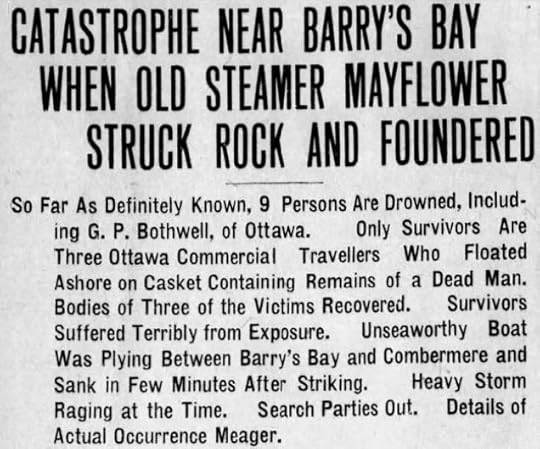
November 14, 1912, p. 1, “The Ottawa Citizen”
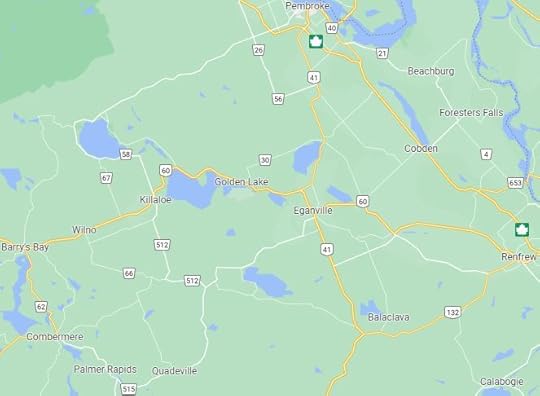
Google map – left section showing Barry’s Bay, Madawaska River
“The seventy-foot steamer, Mayflower, sank ten minutes after striking a rock in the river, about three miles from Barry’s Bay, en route to Combermere, a distance of sixteen miles.”

Nov. 14, 1912, p. 1, “The Ottawa Citizen”
“We were sitting in the engine room when suddenly the water came in
and the boat sank within fifteen seconds.”
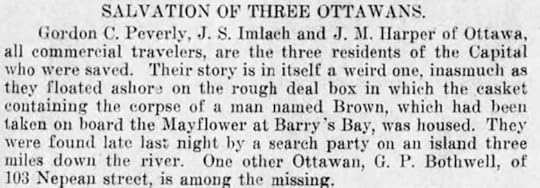
They clung to the casket, the only thing left floating, and made their way to one of the two islands in Kamaniskeg Lake.
“They clung onto the floating casket and set out to the island about 9:00 p.m. about 500 feet away”
Herman Brown
The body in the casket was that of John ‘Herman’ Brown (Braun), unmarried, age 29, (1882-1912), son of Herman Brown (Braun) and Augusta Groskalas. He died on November 7th, of an accidental gunshot wound in Yorkton, Saskatchewan. He was being transported back home, to the village of Schutt, in Renfrew County, his final resting place.
Robert Pachal
Robert Pachal, age 25, born in Ukraine, son of Friedrich Pachal and Wilhelmine Scheler, accompanied the body of Herman Brown, from Saskatchewan to Ontario on the train. Robert was married to Martha Brown, and they had a two year old daughter, Annie, at the time of his death.
“Robert Pachal’s body was found this morning on the shore of the island where the three survivors were found. He came from Yorkton, Saskatchewan with the body of his brother-in-law, Herman Brown, 30 years old, whose remains he was taking to Combermere.”
Nov. 14, 1912, p. 1, “The Ottawa Citizen”
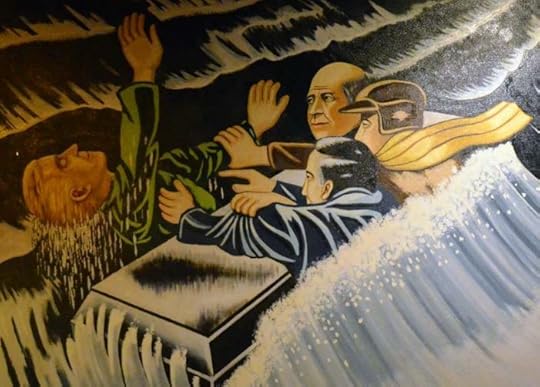

Nov. 14, 1912, p. 1, “The Ottawa Citizen”
“During yesterday’s examination the divers explored the bottom for 100 feet on either side of the steamer, then continued their search for Bothwell’s body.”
Nov. 18, 1912, p. 12, “The Ottawa Citizen”
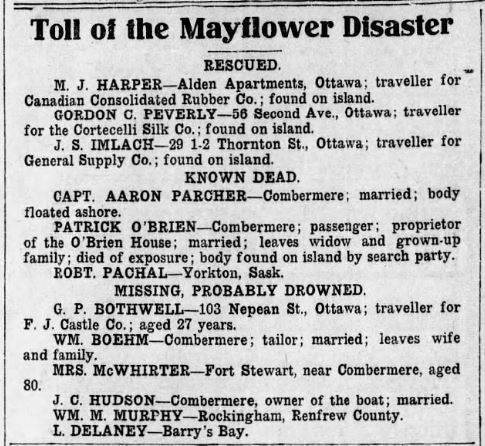
Nov. 14, 1912, p. 1, “The Ottawa Citizen”
Only 3 Survivors:
Harper, Peverly, and Imlach
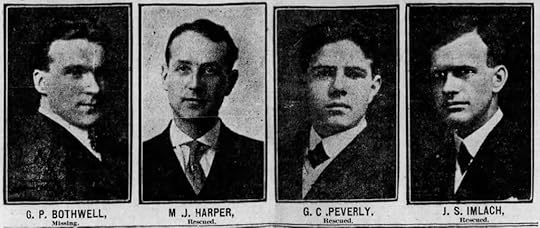
Nov. 14, 1912, p. 1, “The Ottawa Citizen”
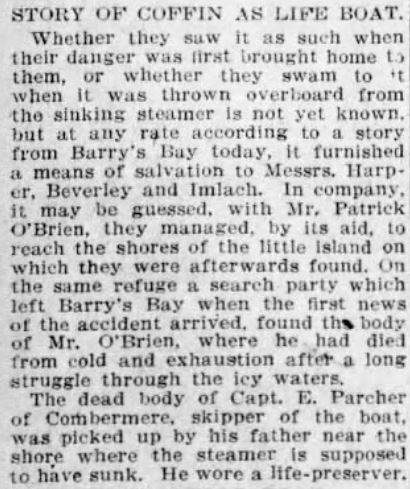
Nov. 14, 1912, p. 1, “The Ottawa Citizen”
How Were They Found?
“As hope began to fade, the 16-year-old son of Silas Parcher, and brother of the crew-member, Aaron Parcher, was walking near the shore with his gun, hunting partridges. He saw a body floating near, which looked like that of his brother. The boy hurried back to his father, who canoed out to find that the body was that of his son. Over on the shore of the island, Mr. Parcher saw what looked like somebody waving something white. He at once hurried to Combermere, six miles away, and there learned that the “Mayflower” was missing, and told what he had seen on the island”
November 18, 1912, p. 12, “The Ottawa Citizen”
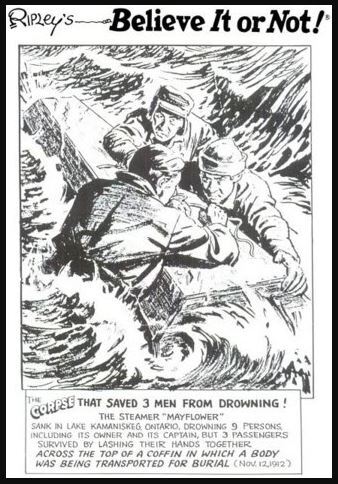 Ripley’s “Believe It or Not”
Ripley’s “Believe It or Not”The Rescue
Gordon Peverley, survivor, described the rescue: “The day wore on. Each tried to cheer the other up. Close at hand lay the body of Mr. O’Brien, and the coffin with the corpse of Herman Brown in it. Mr. Harper was the only one who had an overcoat and we shared it as best we could. All the time we kept asking one another what our opinion was about the fate of George Bothwell. We dared not believe he had perished. When darkness came we tried to keep our hopes buoyant by telling one another that the fire which we took care to keep going would attract the attention of the captain of a passing boat. It must have been nearly nine o’clock when we first heard the whistle of a steamer which we found later to be the “Ruby”. About 20 minutes later we heard the swish of oars and a chorus of voices say, “Hallo boys! Where are you, and how are you?”
Four More Bodies Found
“Word was received last night from Barry’s Bay that four bodies were found together, and all were either in or near the boat, an indication that it went down so quickly as to afford practically no opportunity of escape for most of the passengers.
The bodies located yesterday were those of Elizabeth (Storie) McWhirter, of Fort Stewart, Councillor, William Boehme, of Combermere, Engineer, Tom Delaney, of Barry’s Bay, and Captain John Hudson, of Cobermere. The first three bodies were found in the cabin of the Mayflower, where the victims had been drowned like rats in a trap. That of Hudson was some eight feet away from the bow of the boat.”
November 18, 1912, p. 12, “The Ottawa Citizen”
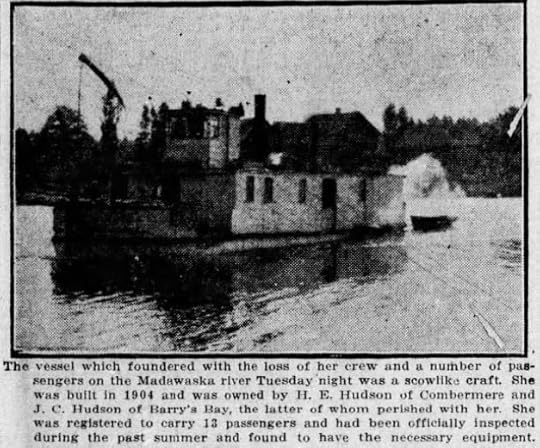
Nov. 14, 1912, p. 1, “The Ottawa Citizen”
William Boehme
William Boehme, born in Brandenburg, Germany in 1853, was a Tailor by trade. At age 32, he married Louise Frederick, in Wilberforce Township, and they had eight children: William (1897-1897) died in infancy, Annie (Dustin) (1888-1969), Herman (1890-1955), William F. (1891-1918), Charles (1892-1892), Hubert Arthur (1894-1894), Female not named (1896-1896), Female not named (1897-1897), only three survived to adulthood.
It was later reported that it was William Boehme, a local Township Councillor, who persuaded Captain John Hudson to embark on one last trip for the season, at 7:00 p.m., to pick up the body of his relative, John ‘Herman’ Brown, from the Grand Trunk Railway station in Barry’s Bay, to be transported home and buried in the village of Schutt before winter. Brown died as a result of a gun accident in Yorkton, Saskatchewan.
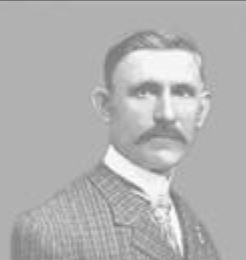
Councillor, William Boehme
Three of the men on the “Mayflower” were politicians.
Captain John Hudson was Reeve of Radcliffe Township, and William Boehme and Paddy O’Brien were both Township Councillors.
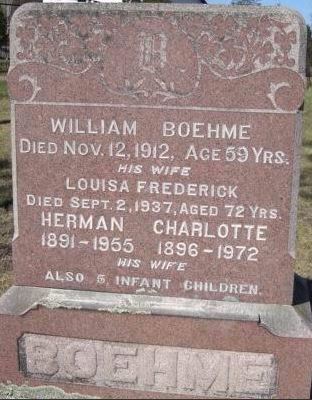
Combermere Methodist Cemetery, Renfrew County
“At the wharf were the wives and families of Paddy O’Brien and William Boehme. They inquired anxiously for news of their loved ones. On hearing the worst they turned away to their homes shaking with sobs. Both Mr. Boehme and Mr. O’Brien were well respected in the village where they lived and both were members of the village council. The late Captain Hudson was the Reeve. All were married men with families.”
November 15, 1912, p. 1, “The Ottawa Citizen”
George H. Bothwell
George Bothwell’s body was the last to be recovered, and was not found until the spring of 1913, in April. His remains were found on the rocks on the east shore of the river, opposite to where the wreck occurred.
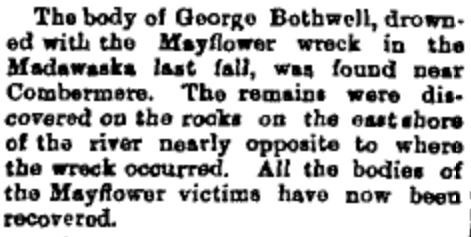
April 25, 1913, p. 8, “The Perth Courier”
George Bothwell, age 27, lived at 103 Nepean Street, and came to Ottawa in 1906 from Aberdeen, Scotland. In 1907 he began working as a Commercial Traveller for the F.J. Castle Company Ltd., a wholesale grocer. He had a regular route of the Barry’s Bay district on behalf of his company. He was not married.
Death Notice: BOTHWELL, George H., drowned on the steamer, “Mayflower”, on the Madawaska River on 12th Nov. 1912, body recovered Monday, April 21st, 1913. Masonic and semi-military funeral will be held on Thursday, 24th inst., at 2:30 p.m. from Roger’s and Burney’s Chapel at 283 Laurier Ave. W., Ottawa.
Elizabeth (Storie) McWhirter
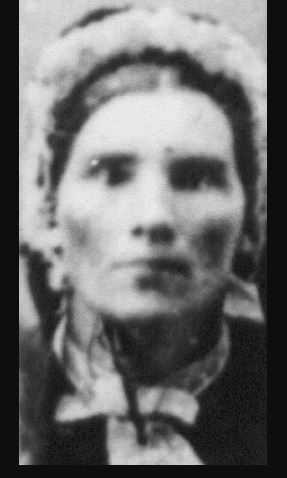
Elizabeth (Storie) McWhirter, the only woman aboard, was the daughter of Scottish immigrant William Storie, Kirkton, Scotland, and Mary Ann McQueen of Kilbirnie, Scotland. Elizabeth and her husband, William, (he died in 1911), had 8 children: Thomas Alexander McWhirter (1854-1935), Jannett McWhirter (1856-1881), Mary McWhirter (1859-1946), Catherine ‘Kitty’ McWhirter (1861-1953), Agnes McWhirter (1862-1958), William Joseph McWhirter (1864-1942), Elizabeth ‘Lizzie’ Stewart McWhirter (1869-1962), and Robert McWhirter (1873-1875)
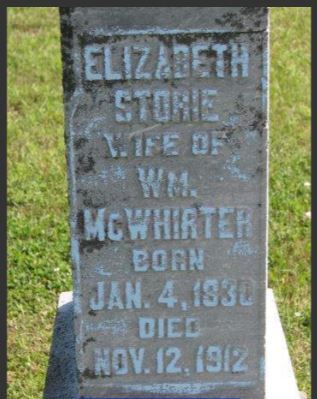
Patrick ‘Paddy’ O’Brien
Paddy O’Brien, son of John O’Brien and Bridget McNamara, drowned at age 60, (1853-1912), he owned one of two hotels located in Barry’s Bay – O’Brien House Hotel.
Born in Pakenham, Lanark County, Ontario, he married Matilda ‘Tilley’ Price, and they had a large family: Maggie, Charles, Howie, Matilda, Patrick, Mildred, Sarah, Walter, and Clara.
At the time of his drowning, most of the children were grown, and their youngest daughter, Clara, was 18.
“Mr. O’Brien made a great effort to reach shore, he was in the water swimming for upwards of two hours, but a few minutes after reaching the shore, died from exhaustion.”
November 14, 1912, p. 2, “The Ottawa Journal”
After Paddy’s death, his wife, Tilley, continued to run the O’Brien Hotel, with the help of their sons, Howie and Walter.
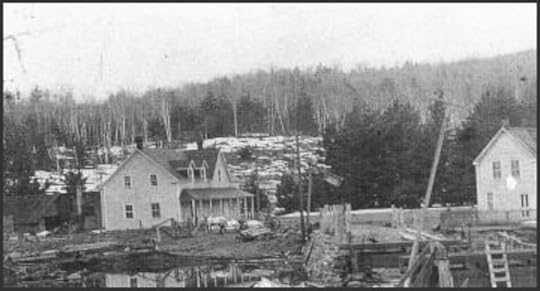
O’Brien House Hotel – 1911
The O’Brien House Hotel was established circa 1880’s, was one of only two hotels in the area, along with Hudson House. The O’Brien Hotel had the first telephone exchange in the area and was used to communicate information to Barry’s Bay in the days after the sinking of the Mayflower.
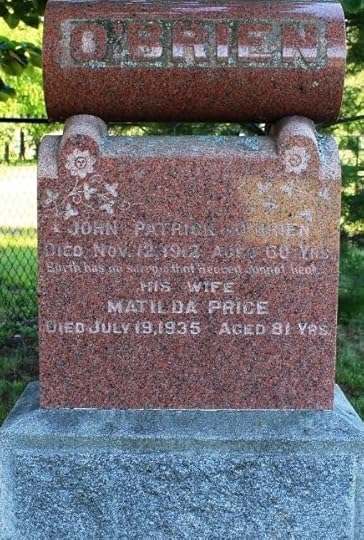
Patrick O’Brien and his wife, Matilda Price O’Brien – Combermere Methodist Cemetery
William Murphy
William Murphy, Irish, age 55, was not scheduled to be on the “Mayflower” on that stormy November night. He was a labourer, and unmarried, and it was only by chance that he decided to go on that fateful voyage.
The Survivors:
Joseph Harper
Joseph Harper, son of Joseph Harper and Matilda Elliott, was born in Forrester Falls, in 1884, and at the time of the shipwreck, at age 27, he was employed with the Dominion Rubber Company in Ottawa, as a Commercial Traveler. He was still a newlywed, having married a Smiths Falls girl, Nellie Ferguson, in June of 1911. They moved to Ottawa that same year, to 207 O’Connor Street. He was employed with the Dominion Rubber Company until his retirement in 1955, and then moved to Almonte. Joe and Nellie had four children: John, George, Betty (Guselle), and Noreen (MacDonald), and at the time of his death in 1957, they also had 11 grandchildren. Joe is buried at the Auld Kirk Cemetery in Almonte, Ontario.
John Imlach
John Stevenson Imlach, born in Carleton Place, Ontario, was one of the three survivors of the wreck of the Mayflower. At that time, in November of 1912, at age 27, he was still a bachelor, living with his parents, at 29 Thornton Avenue, Ottawa. He was a machinist and traveling salesman for the General Supply Company, Ottawa. His brother, Andrew Imlach, was founder and proprietor of the Victoria Garage Company.
“When news arrived of the disaster, Andy Imlach, immediately rushed to Thornton Street and cut the telephone wires so that no news could come through to his mother, until they were certain of his brother’s fate. Not ’till he was in possession of certain intelligence of his brother’s safety that he let his mother know there had been any danger.”
Nov. 14, 1912, p. 2, “The Ottawa Journal”
Four years after the disaster, in the summer of 1916, John Imlach, age 31, fell in love, and married Evelyn Louise May Ready, a schoolteacher. In 1926, they had a daughter, Shirley Isobel Imlach.
Gordon Peverley
Gordon Peverley, son of Clavering Peverley and Jenny Thompson, was born in Quebec in 1884, and was married at age 21, in Montreal, on June 20, 1906, to Mabel Herbert. At the time of the shipwreck, Gordon was 28, and he and his wife lived at 56 Second Avenue, Ottawa, with their two children, Gordon, their eldest, age five years, and baby Howard, who was just five months old. Gordon was a traveling salesman for the General Supply Company, and was doing his usual sales calls in the Barry’s Bay area. When his wife first heard about the Mayflower, it was reported that “all hands were lost”, but she refused to believe that Gordon had perished, insisting that he was a powerful swimmer. She was overjoyed when she heard the news that he had survived. At age 34, Gordon and his family moved to Halifax, where he continued his career in sales. He passed away in 1955, age 70, in Cape Breton. Gordon and Mabel had six children, four who survived to adulthood: Gordon (1907-1989), Harold (1912-2000), Dora (MacDonald) (1915-2013), John (1917-1917 born premature), and Isabelle (Spencer) (1920-1993).
The Inquiry
There were so many reasons that the “Mayflower” should not have taken that final trip of the 1912 season. None of the crew members were licensed, and none had any formal training or certification papers to perform their duties. There were rumours and gossip after the disaster that members of the crew had been drinking at a local hotel before commencing the journey. The “Mayflower” had not been inspected, and was not cleared for operations to transport freight nor passengers. There were only three life-jackets onboard, and no lifeboat. The ship was not equipped with lights sufficient for an evening voyage on a dark November night. There were also reports that it was not the first time the “Mayflower” went down in the waters of the Madawaska River.
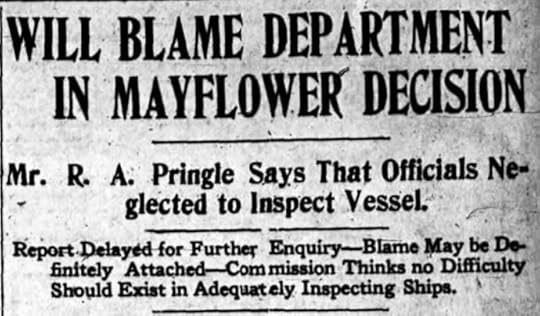
Dec. 31, 1912, p. 1, “The Ottawa Citizen”
The official inquiry blamed the government department for neglecting to inspect the ship.
Mr. R.A. Pringle was the Commissioner appointed by the government to head the inquiry into the “Mayflower” wreck. The Minister of Marine and Fisheries, Hon., J.D. Hasen, asked that they “pursue every possible course to discover where the fault lies and to ascertain why the ship was permitted to run without having complied with the law.” Evidence showed that the ship had no qualified ‘Master in charge’, and that it had no life-boat. Although the total number of ships subject to inspection is unquestionably large, “it is the duty of the government inspectors to see that the small percentage that fail to pass are prevented from running until there is the fullest compliance with the Shipping Act.”
The Tribute
The communities of Barry’s Bay and Combermere marked the 100th anniversary of the sinking by unveiling two new plaques in 2012,- one at the Barry’s Bay wharf, and a second plaque at the Combermere dock, paying tribute to the passengers and crew.
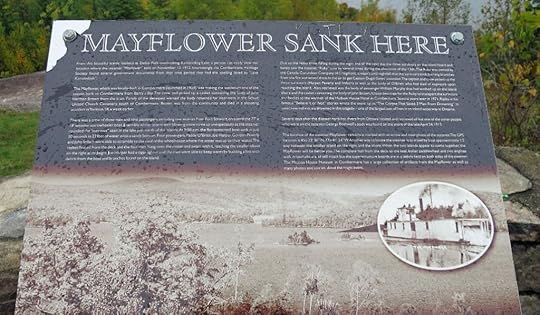
Close-up view of the inscription:
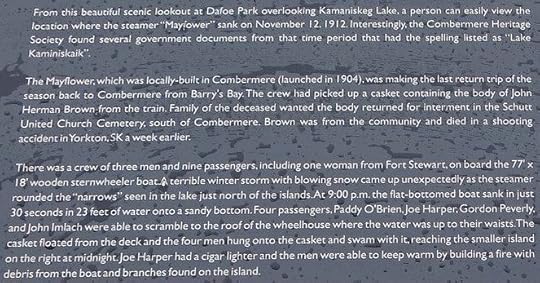

Final Note:
The sinking of the stern-wheeler, “Mayflower”, marked the worst inland maritime disaster in Canadian history of that time. Today, the story of the “Mayflower”, is a legendary part of the history of the Ottawa Valley.

Arlene Stafford-Wilson
Member, Association of Professional Genealogists
Member, Lanark County Genealogical Society
Author of 10 books: “Lanark County Christmas”, “Lanark County Comfort”, “Lanark County Collection”, “Lanark County Calling”, “Lanark County Classics”, “Lanark County Connections”, “Lanark County Calendar”, “Lanark County Chronicle”, “Lanark County Kid”, & “Recipes & Recollections”
available at local stores or email: lanarkcountybooks@gmail.com
October 26, 2022
Nevis Cottage
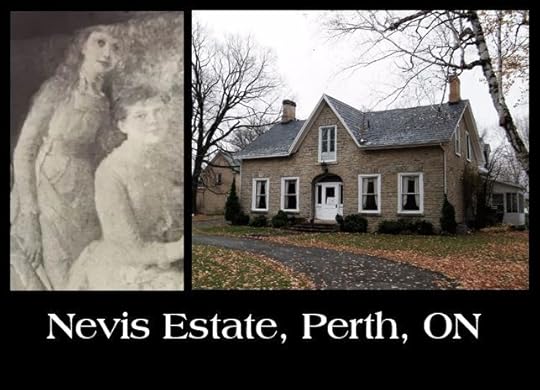
Nevis Cottage
I remember sitting in the back seat of the family car, going over the bumpy railroad tracks on Drummond Street, and asking Dad about the beautiful house, set back far from the road, in the beautiful garden setting. He said the home was called Nevis Cottage, named for the tallest mountain in Scotland, Ben Nevis. It seemed like an odd name for the place, and being a young child I couldn’t grasp why such a large property would be called a ‘cottage’, or why it wasn’t situated along the shores of a lake, like all of the other cottages I knew.
Peter McLaren
The home was built in 1840 by a respected Anglican minister, Reverend Michael Harris, who sold it to a prominent lawyer, Crown Attorney Donald Fraser. Perhaps the most well-known owners of this beautiful property were lumber baron, Peter McLaren, his wife, Sophia, and their children. The McLaren family purchased the property in 1870, along with an additional 400 acres of land beside the property.
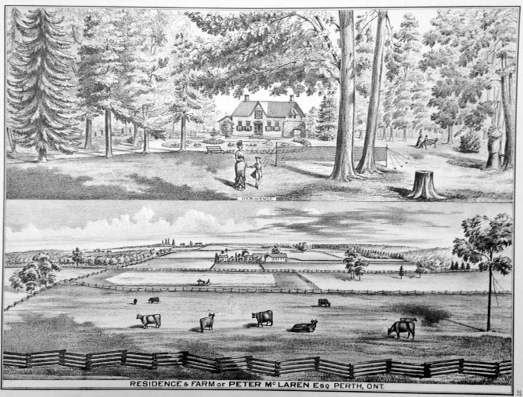
McLaren property, as it appeared in days gone by
Peter McLaren, son of James and Margaret Headrick McLaren, married, on November 22, 1867, at the age of 39, to the lovely Sophia Lees, age 22, daughter of William Lees and Mary Playfair.
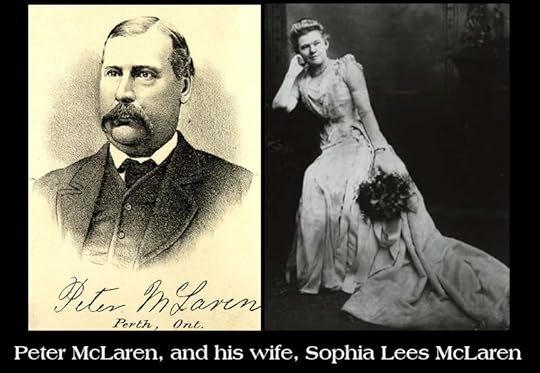
Peter McLaren doubled the size of the original dwelling to 7,700 square feet, extending the back of the original stone house. A large kitchen was added on the main floor, and several additional bedrooms, as well as servants’ quarters were added on the second floor. He also added a 4,700 square foot carriage house in 1880.

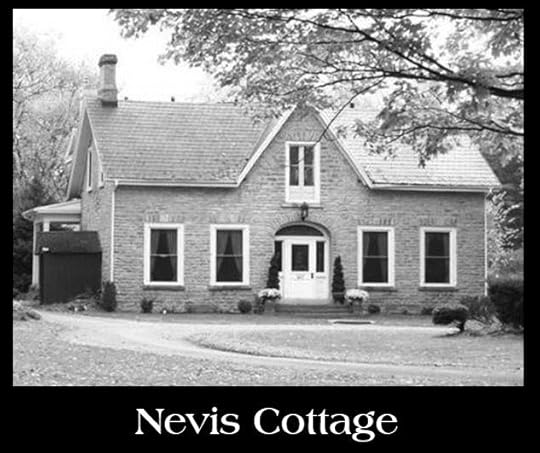
The five McLaren children:
Margaret Elsie McLaren Hall – 1869-1954
Married: November 18, 1903, to F. William Hall, M.P.P. for South Lanark, Barrister of Smiths Falls and oldest son of Francis Alexander Hall, and Harriett Frances Dunham Hall, of Perth. They lived for a while in the Perth area, and later moved to Oshawa. They had no children. Margaret died at age 85, in Oshawa.
Mary Isobel McLaren Benedict – 1874-1927
Married: at age 23, at St. James Anglican Church, Perth, June 22, 1897, to Charles Benedict, they moved to Toronto, where Charles worked at the Bank of Montreal. They had three children: Charles, born in 1900 and died as an infant, Doris Sophia, born in 1902, and Peter McLaren Benedict, born in 1907. Mary died at age 53 in Toronto.
Annie ‘Kathleen’ McLaren – 1875-1954
Kathleen chose to remain single, did not have any children, and was the last of the family members to reside at Nevis Cottage. When Kathleen passed away in 1954, age 79, she died without heirs. The McLaren estate, consisting of the grand house, the 600 surrounding acres, and all of the valuable artwork, jewelry, and fine furnishings, required the distinguished auction house of Ward-Price from Toronto, to appraise the family’s vast collection. Because she left no heirs, the estate of Kathleen McLaren caused a great deal of in-fighting, with claims to the estate and litigation that went on for many years after her death.
James Lyon Playfair McLaren 1878-1934
At age 27, James married Isabel Frances Geddes on February 14, 1906 at St. George’s church, Ottawa. Isabel was the daughter of Charles Geddes and Selina Sweetland. They had two children: Peter McLaren, born 1907, and Selina Sophia ‘Ena’ McLaren, born 1909. They moved to Springfield, New Hampshire. James passed away at the age of 57 at Springfield. The funeral was held at Nevis Cottage.
William Lees McLaren – 1880-1932
On October 14, 1910, at age 30, William ‘Willie’ McLaren married Anna Gemmill at her parents’ cottage on the Rideau Lakes. Her parents were Lawrence Gemmill and Elizabeth Kellock Gemmill. As a wedding gift, Senator (Peter) McLaren gave Willie and Anna a mining property on Otty Lake, known as Forest Lodge. They lived there and ran the mine. Willie passed away after an illness, at the Montreal hospital, at the age of 53. The funeral was held at Nevis Cottage. Willie and Anna had no children.
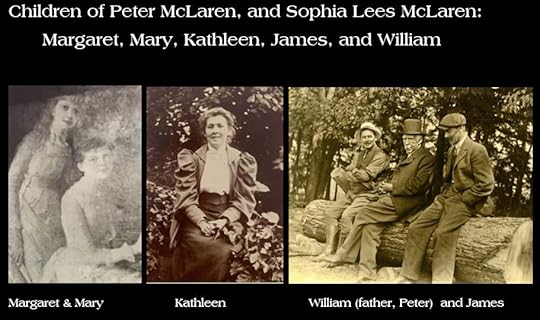
“William and James, were sent to a private boarding school
in Edinburgh, Scotland.”
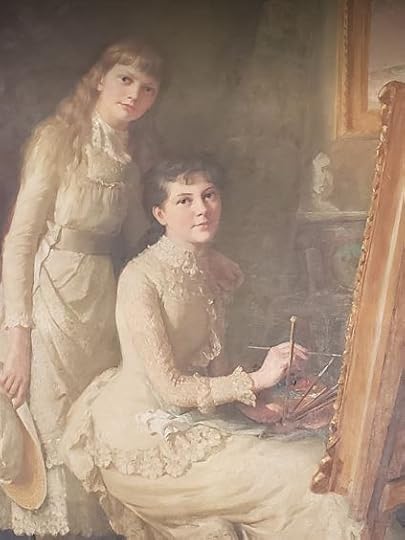
Peter McLaren commissioned artist John Wycliffe Lowes Forster (1850-1938) to paint his daughters, Margaret and Mary. The painting is currently housed at the Perth Museum. (Forster’s paintings are among those in the permanent collections of the National Gallery of Canada in Ottawa. Some of his memorable works include portraits of Sir Wilfred Laurier, Timothy Eaton, and Sir Sanford Fleming.)
1977 House Tour
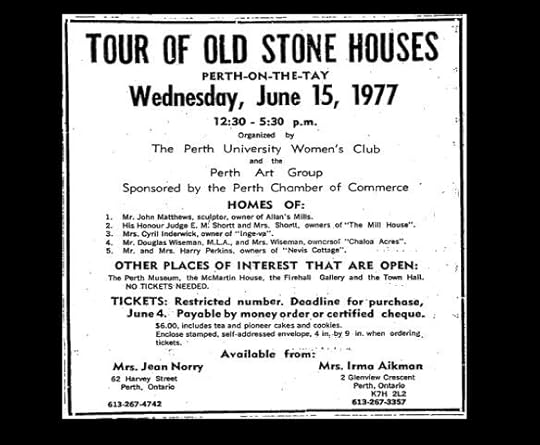
May 26, 1977, p. 12, “The Perth Courier”
In 1977, the Perth University Women’s Club organized a tour of Old Stone Houses, which included Nevis Cottage. At that time the property was owned by Mr. and Mrs. Harry Perkins.
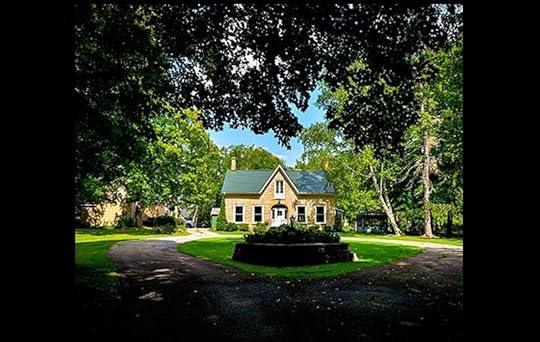
Modern view of Nevis Estate
Today, Nevis Estate is a bed and breakfast, located at 61 Drummond St. W., in Perth, Ontario.
In 2018, this video of Nevis Estate was featured on YouTube, and gives the viewer a glimpse at the lovely interior of the home, with all of its many entertaining spaces, and large, gracious bedrooms.
To view the video:
Although Nevis ‘Cottage’ looks very different today than it did when Senator Peter McLaren and his wife Sophie occupied the house remains a lovely property and will always be one of the notable homes in Perth’s long history.
Many years have passed since I first noticed the home, as I sat in the backseat of Dad’s old Buick, face pressed against the window, in the bumpy ride over the train tracks on Drummond St. I still love to hear the stories of the old days when the McLaren family lived there. In my mind I imagine the children – Margaret, Mary, Kathleen, James and Willie, running across the wide lawns, laughing and playing in their enormous yard. I can picture smartly-dressed servants carrying cool glasses of lemonade and biscuits to Mrs. McLaren and her friends, as she entertains them on the back lawn.
As the pink sun sinks low in the sky and the day draws to a close at Nevis Cottage, we can picture Senator Peter McLaren arriving home after a long day overseeing his lumber business. He hands his cane and hat to the house maid as he enters, and greets Sophia and the children warmly, as they prepare to sit down to a sumptuous meal, in their elegant home. Another perfect evening at Nevis Cottage.

Notes:
(In 1983, a magazine called,”Canada Century Homes”, featured Nevis Cottage, as well as The Crain House, The Mill House, Inge-Va, and Matheson House)
(photo of the painting of the McLaren girls, courtesy of the Perth Museum)

Arlene Stafford-Wilson
Member, Association of Professional Genealogists
Member, Lanark County Genealogical Society
Author of 10 books: “Lanark County Christmas”, “Lanark County Comfort”, “Lanark County Collection”, “Lanark County Calling”, “Lanark County Classics”, “Lanark County Connections”, “Lanark County Calendar”, “Lanark County Chronicle”, “Lanark County Kid”, & “Recipes & Recollections”
available at local stores or email: lanarkcountybooks@gmail.com
October 25, 2022
“The Hoax”, Filmed in Perth

The Strange Case
of the Fanged Skull
Filmed in the town of Perth, Ontario, in 1955, this movie features many local people, in a tale of mystery and suspense.
Plot:
Set in the town of Tayville, (Perth), the local museum (the Perth Library on Gore Street) finds itself the center of an intriguing drama when an ambitious young reporter causes a scandal over the authenticity of one of its prize exhibits, a human skull.

Gore Street – 1955, appears many times, filmed from various angles

Local businessman, Victor ‘Vic’ Lemeiux playing the role of Vic Edwards, the Editor of the ‘Tayville Times’, with Richard Lamb, playing Harry Raddall, the ambitious young Reporter
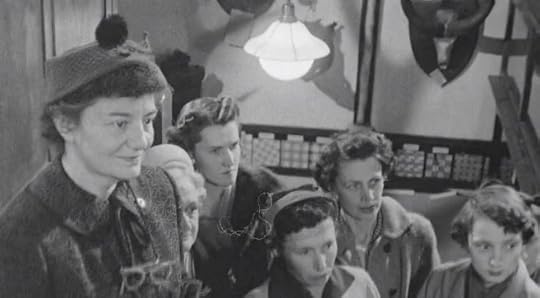
A local fundraising group tours the museum
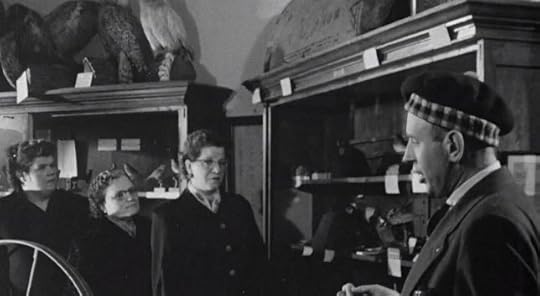
Mr. Appleby, the Museum Curator, played by Clyde Bell, provides a guided tour of the museum
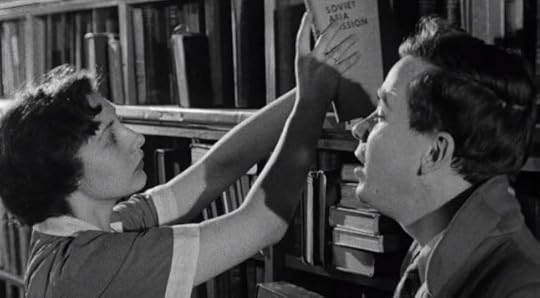
Harry Raddall, reporter, played by Richard Lamb, tells lovely librarian, Helen Tate, played by Joy Lindop (Cunningham), about his plan to sneak into the library late at night and photograph the museum’s fanged skull

The fundraising group concludes their tour with the curator

Reporter, Harry Raddall, played by Richard Lamb, sneaks into the Museum at night, under the cover of darkness…to photograph the skull
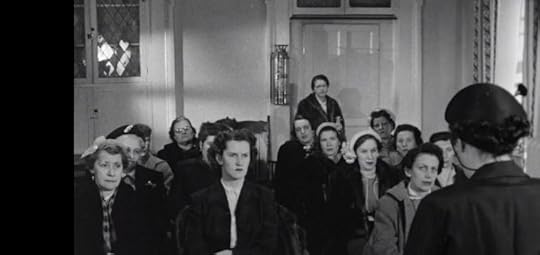
The shocking newspaper headlines are revealed at a fundraising meeting, “Skull With Fangs Declared a Hoax!”
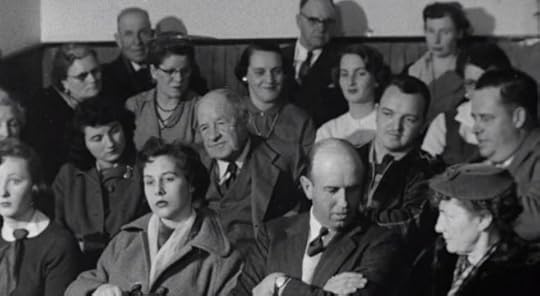
A Town Council meeting is held at the Perth Town Hall to decide whether the museum will receive funding

Professor Goddard, played by Peter Hopkinson, examines the skull to establish authenticity

Is the skull real? Or is it a hoax?
“The Hoax”
This delightful short film, just over 28 minutes in length, is a wonderful glimpse into the past, with many scenes of Gore Street, Perth, Ontario, as it appeared in 1955.
The local cast of actors did a fine job in their roles, many with memorable performances.
This historic film short may be viewed in its entirety on the National Film Board’s website, and is a must-see for local history buffs, capturing scenes of the main street of Perth as they appeared in the mid-1950s.
Enjoy!
View “The Hoax”
on the National Film Board site: https://www.nfb.ca/film/hoax/
(All Images are from: “The Hoax”, a movie by the National Film Board of Canada, produced in 1955.)
Director: William Davidson
Story and Screenplay:Norman Klenman
Photography: Robert Humble
Sound: Clifford Griffen
Editing: Douglas Robertson
Production: Nicholas Balla
Cast:
Harry Raddall, Reporter: played by Richard Lamb
Helen Tate, Librarian: played by Joy Lindop (Cunningham)
Mr. Appleby, Curator: played by Clyde Bell
Professor Goddard: played by Peter Hopkinson
Mrs. Tate: played by Mrs. T.A. Rogers
Vic Edwards, Newspaper Editor, played by Victor ‘Vic’ Lemieux
Also featured in ‘The Hoax”:
Vince Lally, Jo Keays, Jack Finnegan, Edna Coutts, Mayor Scott Burchell, John Mather Town Clerk, Mr. ? Arbuthnot, Grace Grainger, Norm Turner, Mr. ? Sawdon, Mrs. ? Hamilton
(and many more)
Please comment below to help identify the local actors from the Perth area so they can be listed with the other members of the cast.

With thanks to the local cast and crew, and to the National Film Board of Canada, for capturing these moments in time, and preserving this special slice of history for the town of Perth, Ontario.

Arlene Stafford-Wilson
Member, Association of Professional Genealogists
Member, Lanark County Genealogical Society
Author of 10 books: “Lanark County Christmas”, “Lanark County Comfort”, “Lanark County Collection”, “Lanark County Calling”, “Lanark County Classics”, “Lanark County Connections”, “Lanark County Calendar”, “Lanark County Chronicle”, “Lanark County Kid”, & “Recipes & Recollections” available at local stores or email: lanarkcountybooks@gmail.com
October 23, 2022
Irish Settlers & the Ghost of Burgess Township
The story of the Burgess Ghost begins with the arrival of so many Irish to the areas around Westport, the Scotch Line, Black Lake, and Stanleyville, that it became known as the ‘Irish Invasion’.
This is the the home where the story took place, in the cold, bitter winter of 1935, at the home of Mr. John Quinn. John lived in the house with his wife, and two sons Michael age 13, and Stanley, 11.
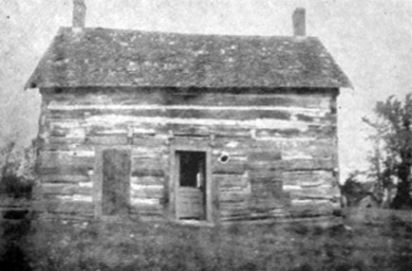
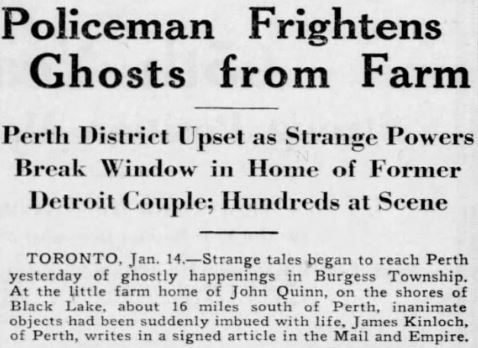

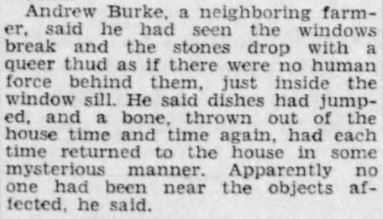


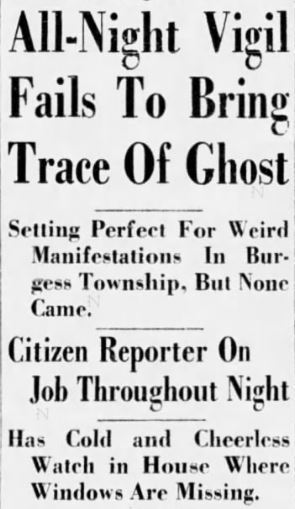
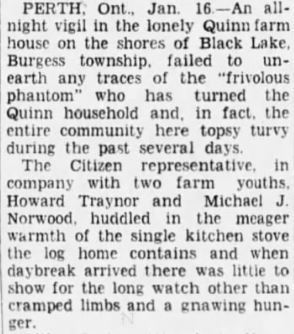
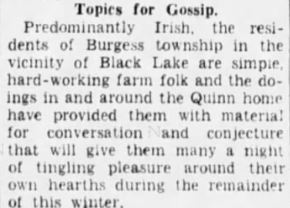
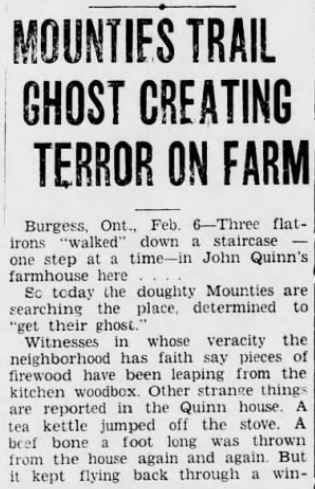
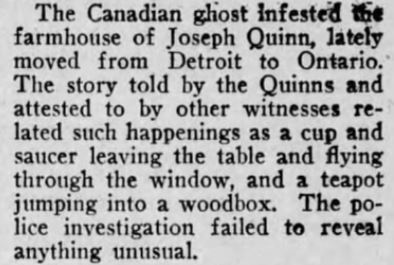
“Strange occurrences were happening in 1935 at a farm in North Burgess just off the Narrows Locks road. Mr. John Quinn, his wife and two children, Michael, and Stanley, ages 13 and 11, reported innumerable phenomena taking place in their home. Stove lids, according to the Quinns, “danced” in the air, the teapot “jumped” off the stove into the wood box, three flat irons “walked” down a staircase and dishes “pranced” on the dining-room table. Word of this mysterious goings on spread quickly throughout the district. Although, perhaps skeptical, hundreds of persons from miles around flocked to the Quinn home.
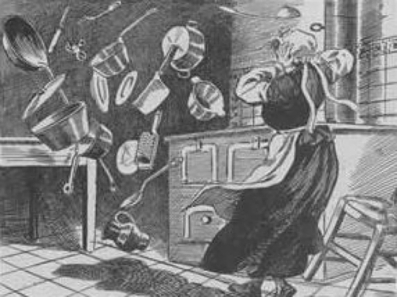
On the Sunday after the reporting of the “ghosts” more than 100 cars arrived at the Quinn farm. Along with the cars a flotilla of cutters and sleighs dotted the white-capped farm. The snow fell incessantly and the thermometer dipped way below the zero mark.
Newsmen from across the country arrived, and the CBC news from Toronto, reported the strange events. Although the strange occurrences could not be readily explained, many held doubts in their minds as the credulity of the phenomena. Believing that there had to be a reasonable explanation behind the occurrences, the Perth detachment of the OPP decided to hold an investigation.
On a Saturday afternoon, members of the force motored to the Quinn home, and inspected the building. Nothing strange occurred while they were there. That same evening Inspector Storey returned to the house. He remained there until Sunday morning along with about a dozen district men, sat in the house, speaking in hushed tones, but again nothing happened.
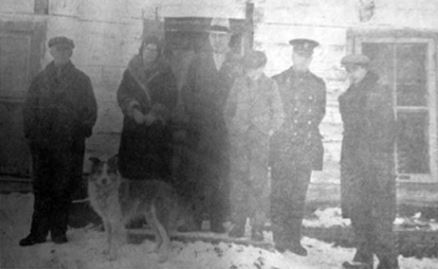
Mr. Quinn was unable to explain the strange occurrences that had been going on for the past couple of weeks. Pieces of beef he had placed in a barrel had been found littered throughout the house, he said, and the Wednesday before a window pane crashed for no apparent reason. He had not thought that too odd until it happened the very next evening.
Andrea Burke, a neighbouring farmer, declared that a bone thrown out of the home time and time again had always returned to the house for no explicable reason. Another neighbour, William Cordick, swore that he had seen three flat irons descend the Quinn’s staircase one after another.”
………………………………………………………………………………………………………………………………………..
Irish Settlers to North Burgess Township, Lanark CountyMost, but not all of the Irish in North Burgess Township, came from County Down and County Armagh, and many came in the 1840s, to escape a horrible famine, that swept through Ireland like an unstoppable plague. A disease called Potato Blight ravaged their crops for nearly a decade, and during that time over a million died of starvation, and an equal number fled Ireland on ships sailing to Canada and the United States.

Most were tenant farmers, leasing their land; unable to pay their rent when their crops failed, and were evicted by ruthless landlords. They bundled up what little they had, and boarded ships headed for the new world.
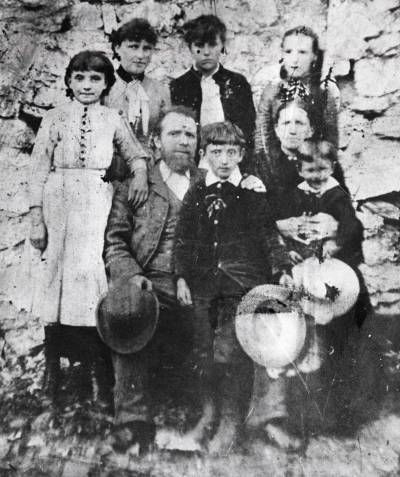
Seven weeks was the average length of time spent at sea, and the conditions endured by these Irish immigrants were so terrible that the ships were nick-named ‘coffin ships’. The lice, ticks and fleas common in these over-crowded vessels were the ideal breeding grounds for the transmission of disease, and by 1847 an average of 50 passengers died each day of typhus on their voyage from Ireland.
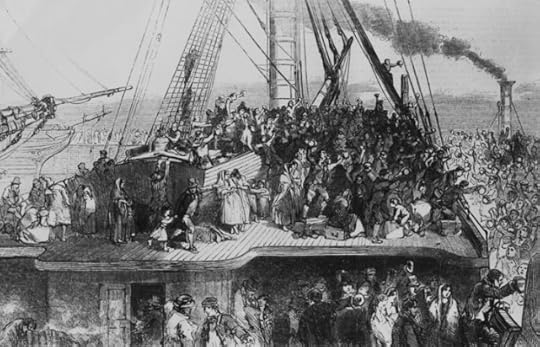
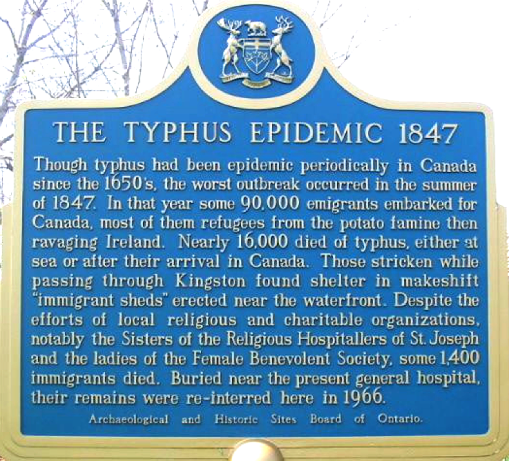

These new settlers brought their traditions, customs, and stories with them to the new country. Stories and legends were passed down from father to son, and from mother to daughter. Tales from the old country were told in the evenings by the fire, and the one story that seemed to run up and down the concessions in North Burgess was the legend of the Irish Banshee.

The Banshee, or ‘Bean Sidhe’ is an Irish spirit, and her high-pitched wail foretells of a death in the family. It was said that each family had its own Banshee, and that they travelled with them from the old country. Some said that the family’s Banshee would stay in Ireland at the family’s estate, and mourn the dead. The settlers to the new land brought their vivid descriptions of the Banshees – some claiming that she was an old hag with red eyes, but others said she was a fair, pale Irish beauty with long red hair dressed in a flowing gown.
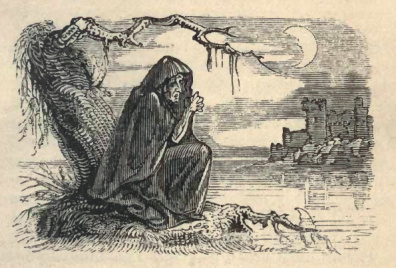

It’s been said that whoever hears her high and piercing shriek could be sure that there would be a death within 24 hours. Irish lore tells that the Banshee always wailed when a family member dies, even if the person had died far away, and news of their death had not yet come. The wailing of the banshee was the first warning to the household of the death.
When several banshees appeared at once, it was said to foretell of the death of someone prominent, or of an accidental or unintended death – often of a murder victim, a suicide, or a mother who died in childbirth.
The early settlers in North Burgess passed down their stories of banshees, fairies, ghosts and the little people. Although they were fiercely loyal to God and to the church, they never abandoned their beliefs in the spirits and creatures of their ancient folklore.
The Story of the Burgess Ghost became a local legend….The story of the ghost in the Quinn house was passed down through the years, told and retold at family gatherings, around campfires, and particularly in the weeks each year leading up to Hallowe’en.
In a strange final twist to the mystery of the Burgess Ghost, the Quinn family home burned to the ground. The cause of the fire was never determined, and remains a mystery to this day…..
In 1972, the Quinn home was burned to the ground.

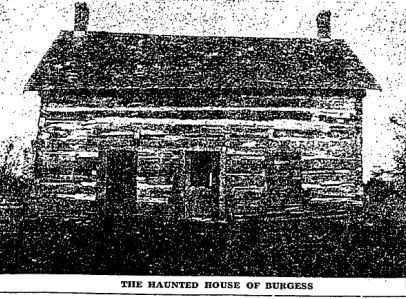
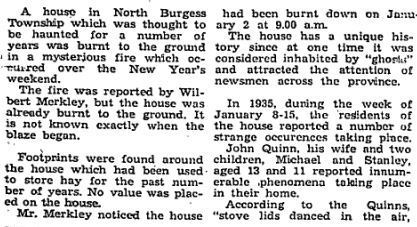
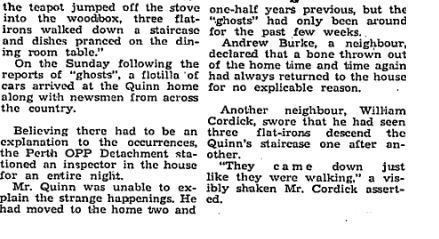
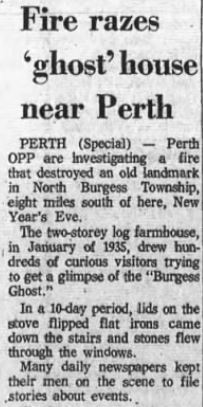
………
In 2002 the townships formerly known as North Burgess, South Sherbrooke and Bathurst were part of an amalgamation, and adopted the name of Tay Valley Township, as they are known today.
……..
For genealogical records of the founding families of North Burgess Township:
http://www.rootsweb.ancestry.com/~onlanark/nburgess.htm
St. Bridget’s Cemetery Staneyville Ontario
Roman Catholic interments North Burgess Township
Scotch Line Cemetery – Burials from 1822-2000 North Burgess Township
Scotch Line Cemetery – North Burgess
Lanark County Genealogical Society
Archives Lanark
http://archiveslanark.ca/index.php
Search the census records for North Burgess Township, Lanark County
Searchable online census records for Lanark County
……………
For more information on Irish Folklore in the early days of Lanark County:
‘Banshees of Burgess’, is part of a collection of short stories in ‘Lanark County Classics – A Treasury of Tales from Another Time’. The reader will discover more about the early families from Ireland who settled in Lanark County, and their customs and beliefs in the supernatural, brought from the old country. The story explores some of the tales passed down by these Irish settlers, and documents their personal experiences with Banshees, ghosts, and fairies while living in Lanark County.
Available at The Book Nook, Spark Books & Curios, Mill St. Books and online.“Lanark County Classics” – ISBN 978-0-9877026-54
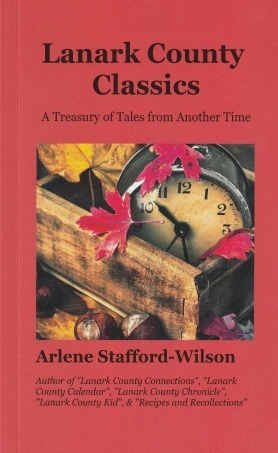
…..
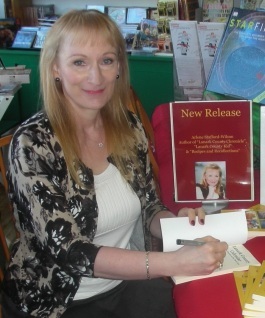
Arlene Stafford-Wilson
(map of Northern Ireland – By Maximilian Dörrbecker (Chumwa) – map by NNW, CC BY-SA 2.5, https://commons.wikimedia.org/w/index.php?curid=7918534)October 20, 2022
Ottawa Valley Poltergeist

This eerie tale began in the autumn of 1889, on a farm, owned by George Dagg, and his wife, Susan, located in Clarendon, 10 kilometers from Shawville, Quebec.
George and Susan had three children at that time, Eliza, age 4, Mary, age 3, and baby John. The Dagg family had also taken in a young girl, 11-year old Dinah. Like many orphans from the U.K. at that time, she was brought to Canada, and these children were often placed in farm homes, where they could help out.
When Dinah was present, there were often unexplained, spontaneous fires — eight occurring in a single day. Objects – a water jug, butter tub and wash basin ‘flew’ around the property controlled by an “invisible agency.” Stones were thrown through windows, a harmonica played on its own, and an empty rocking chair, rocked back and forth.
Family members and neighbours heard a deep gruff voice, sounding like an old man, in the house and outdoors, and the voice answered questions, and was heard by all.
It all began on September 15, 1889…..
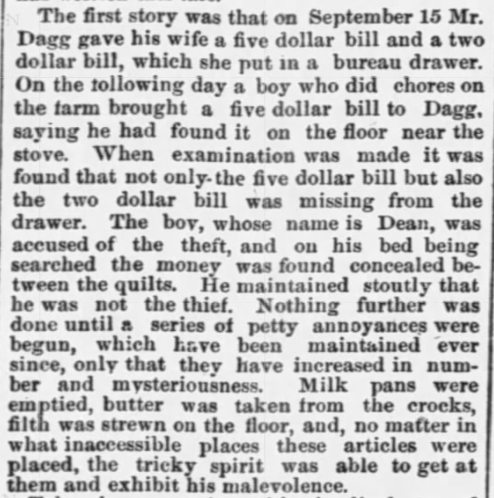
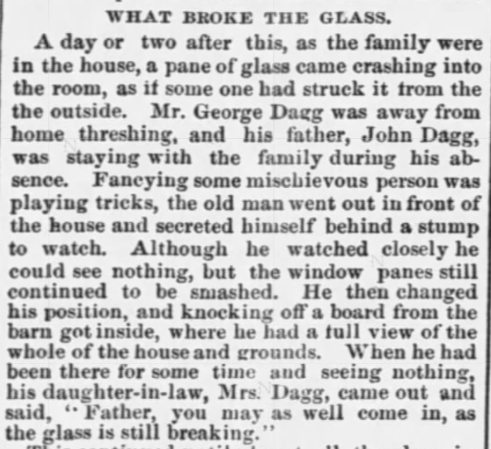
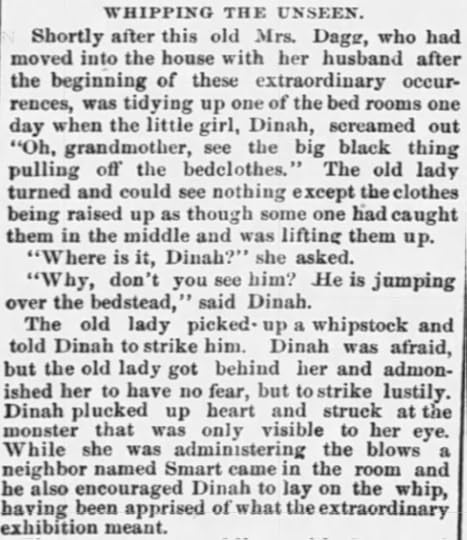
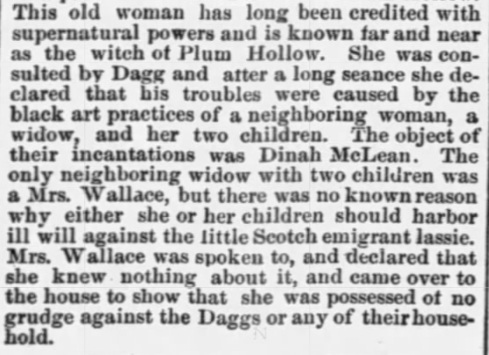

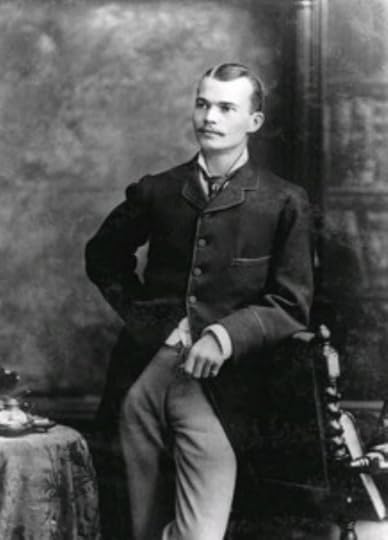 Percy Woodcock, 1879Was it the farm-hand, Dean?
Percy Woodcock, 1879Was it the farm-hand, Dean?
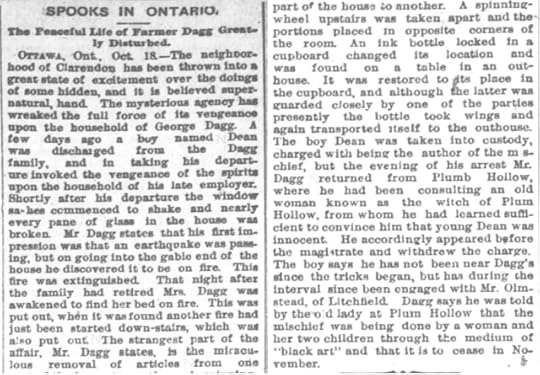
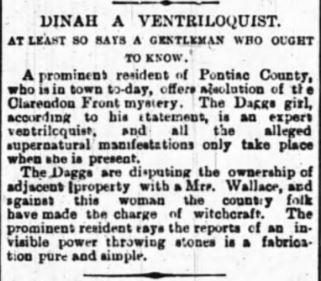
Dinah Burden McLean, the adopted orphan from Scotland, taken in by the kindly Dagg family, was blamed for the disturbances, and eventually was sent away to Fairknowe Home, in Brockville. Fairknowe Home was an orphanage, and at the time Dinah was sent there, it was called The National Orphan Homes of Scotland, and later the building housed a division of the Brockville Children’s Aid.

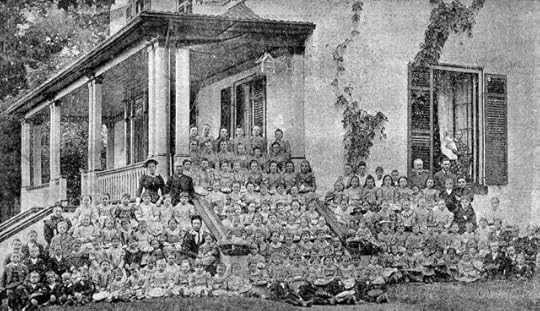

Seventeen farmers and community leaders, including local politicians and clergymen, signed witness statements to the unusual sightings, and voices heard at the Dagg farm, in the fall of 1889.
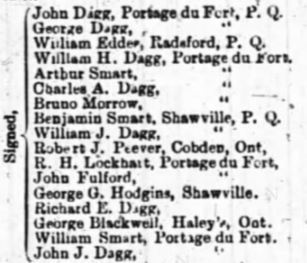
We, the undersigned, solemnly declare that the following curious proceedings, which began on the 15th day of September, 1889, and are still going on, on the 17th day of November, 1889, in the home of Mr. George Dagg, a farmer living seven miles from Shawville, Clarendon Township, Pontiac County, Province of Quebec, actually occurred as below described.
1st, That fires have broken out spontaneously through the house, as many as eight occurring on one day, six being in the house and two outside; that the window curtains were burned whilst on the windows, this happening in broad daylight whilst the family and neighbours were in the house.
2nd, That stones were thrown by invisible hands through the windows, as many as eight panes of glass being broken; that articles such as waterjug, milk pitcher, a wash basin, cream jug, butter tub and other articles were thrown about the house by the same invisible agency; a jar of water being thrown in the face of Mrs. John Dagg, also in the face of Mrs. George Dagg, whilst they were busy about their household duties, Mrs. George Dagg being alone in the house at the time it was thrown in her face; that a large shelf was heard distinctly to be played and was seen to move across the room on to the floor; immediately after, a rocking chair began rocking furiously. That a washboard was sent flying down the stairs from the garret, no one being in the garret at the time. That when the child Dinah is present, a deep gruff voice like that of an aged man has been heard at various times, both in the house and outdoors, and when asked questions answered so as to be distinctly heard, showing that he is cognizant of all that has taken place, not only in Mr. Dagg’s family but also in the families of the surrounding neighbourhood. That he claims to be a discarnated being who died twenty years ago, aged eighty years; that he gave his name to Mr. George Dagg and to Mr. Willie Dagg, forbidding them to tell it. That this intelligence is able to make himself visible to Dinah, little Mary and Johnnie, who have seen him under different forms at different times, at one time as a tall thin man with a cow’s head, horns and cloven foot, at another time as a big black dog, and finally as a man with a beautiful face and long white hair, dressed in white, wearing a crown with stars in it.
Signed,
John Dagg Portage du Fort, PQ.; George Dagg, Portage du Fort, PQ; William Eddes, Radsford, PQ; William H. Dagg Port. du Fort; Arthur Smart, Port. du Fort; Charles A. Dagg, Port. du Fort; Bruno Morrow, Port. du Fort; Benjamin Smart, Shawville, PQ.; William J. Dagg, Shawville, PQ.; Robert F. Peever, Cobden, Ont.; Robert H. Lockhart, Port. du Fort; John Fulfrid, Port. du Fort; George H. Hodgins, Shawville; Richard F. Dagg, Shawville; George Blackwell, Haley’s, Ont.; William Smart, Portage du Fort; John J. Dagg, Portage du Fort.”

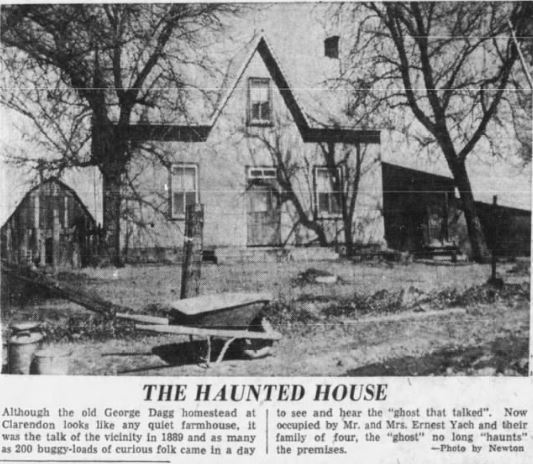
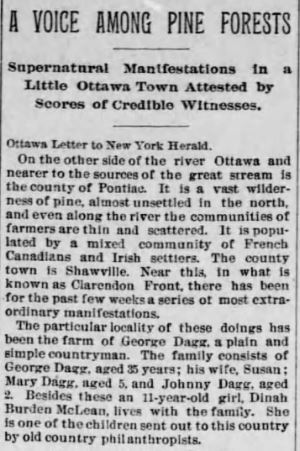
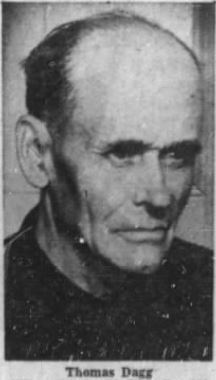
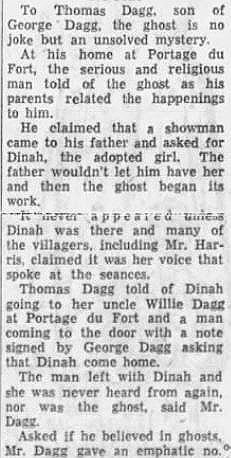
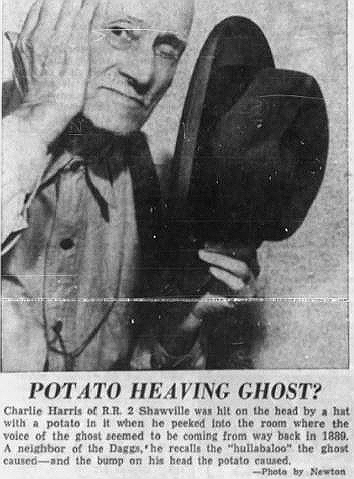


Noted by the Lombard family – a strange sound of crawling and scratching in the attic, solely focused above the original house.
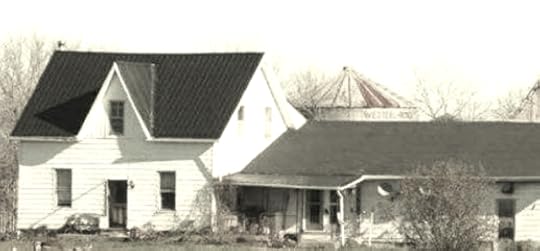
Eliza Jane, age 4, the Dagg’s daughter, died mysteriously, during the time of the poltergeist’s visit.
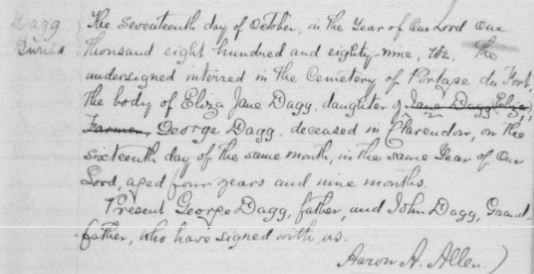
Grave of Eliza Dagg, daughter of George and Susan Dagg. She passed away in a mysterious accident, during the time of the poltergeist on the family farm. (local lore is little Eliza was playing near a cauldron of soap, her clothing caught fire, and she burned to death)
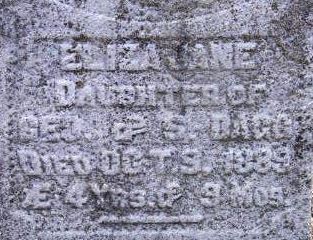
After the disturbances of 1889, the lives of George Dagg and his family returned to normal, for the most part. George became one of the most prominent farmers in the region, and served as a Councillor for Portage from 1918-1922. Popular, and well-respected, he ran for Mayor in 1922, and was elected. He served as Mayor of Portage for 16 years, right up until his death, in 1938.
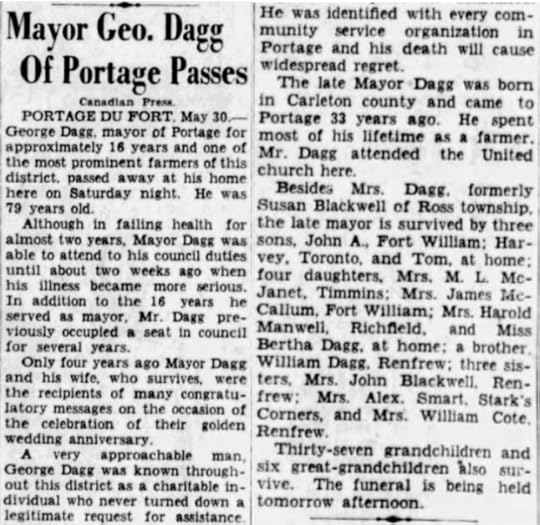
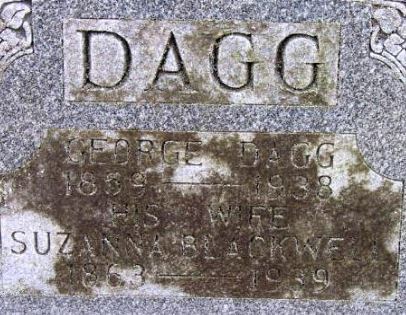
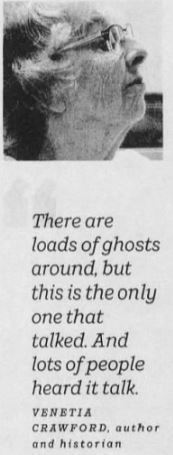
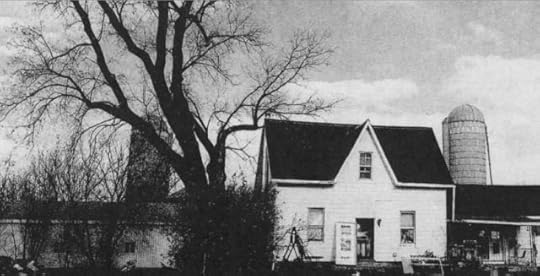
The old-timers say that the poltergeist vanished, and appeared like a streaking flame, as it finally left the Dagg farm, after three long months, of troublesome behavior.
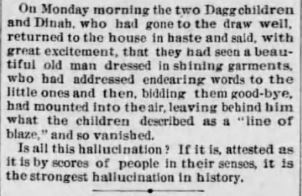
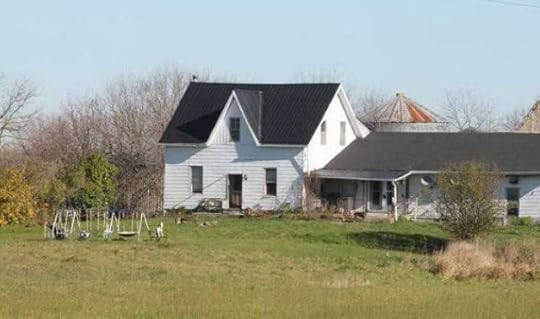
The Dagg House, as it appears today. Local people and curiosity seekers still drive by this property, and local teens have been known to walk through the yard at night, on a dare.
Would You Dare to Visit at Night?
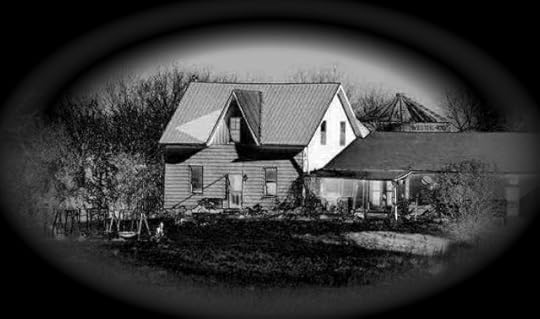
Exploring the Supernatural: The Weird in Canadian Folklore
1955. R.S Lambert’s book Exploring The Supernatural: The Weird In Canadian Folklore was published, which includes a chapter of what took place at the farm in 1889.
…..
The Ghost that Talked
The Dagg poltergeist was the subject of 1957 National Film Board movie, “The Ghost That Talked.”
“In the fall of 1889 a mysterious presence took up residence in the Dagg farmhouse in Pontiac county, Québec. This dramatization based on the first-hand report by Canadian artist Percy Woodcock shows that ghosts and poltergeists are as common in Canada as in the Old World.”
March 10th, 1957, 30 min.
…….
Fairknowe Home
For more information on Fairknowe Home, orphanage in Brockville: “The Village, A History of Quarriers” , by Anna Magnusson, 1984.
…….
Arlene Stafford-Wilson
Member, Association of Professional GenealogistsMember, Lanark County Genealogical SocietyAuthor of 10 books: “Lanark County Christmas”, “Lanark County Comfort”, “Lanark County Collection”, “Lanark County Calling”, “Lanark County Classics”, “Lanark County Connections”, “Lanark County Calendar”, “Lanark County Chronicle”, “Lanark County Kid”, & “Recipes & Recollections”available at local stores or email: lanarkcountybooks@gmail.comOctober 19, 2022
UFO Sightings In Lanark County
Since the infamous sightings in Roswell, New Mexico in 1947, people across North America have become more aware of strange lights, and unusual objects, in the night skies.
By the late 1960s in Lanark County, details of sightings were published in the local papers, and many credible witnesses reported their accounts of these strange events.
Flying Saucers With Red Lights Over Port Elmsley Confirmed by Perth OPP


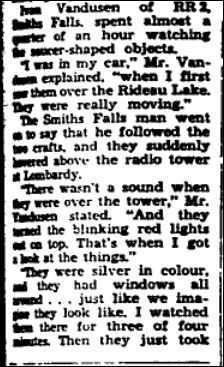


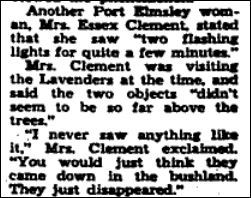
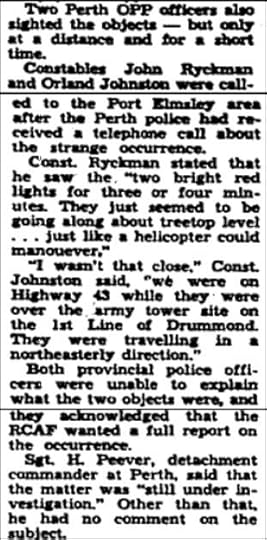
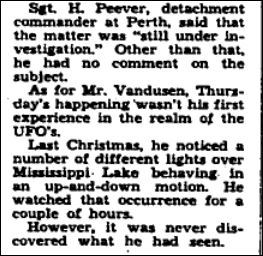
The night skies in Eastern Ontario became very active in the summer and fall of 1973, and some organizations reported that it was one of the largest number of U.F.O. sightings over North America, calling it the ‘Autumn of Aliens’.
Huge Chunks of Ice Fell from the SkyIn Lanark County, it all seemed to begin with a sudden hailstorm, on the Friday the 13th of July. The hailstorm came out of nowhere, and huge chunks of ice fell, many almost three inches in diameter. Hundreds of windows and car windshields were smashed by jagged pieces of ice. A Smiths Falls resident was cut on the head by a chunk of falling ice, and required seven stitches. No one was seriously injured, although there were a few farmers that got caught outside, working in the fields, and had to seek shelter from the large chunks of ice falling from the sky.

Barely 48 hours after the hailstorm, police departments in Perth and Smiths Falls received a number of calls from residents, claiming to have seen flying objects in the sky.
Flying Object Seen Near BaldersonA local man reported that he and five others were on the Eighth Line near Balderson at 9:30 p.m., when a flying object appeared to be travelling south to north, then returned to the south. He observed that it was quite large, shaped like a tart. Another report came in from a resident of Sherbrooke Street in Perth, who saw the same object overhead. He said that his dog had howled constantly while the object appeared in the sky.
CJET Radio holds call-in show due to large number of UFO SightingsSo many people had observed the same object that CJET radio station in Smiths Falls held a call-in show the following Monday, so that people could phone the show, and share reports of what they had seen.
Sparkling Yellow-Orange Light Over Perth

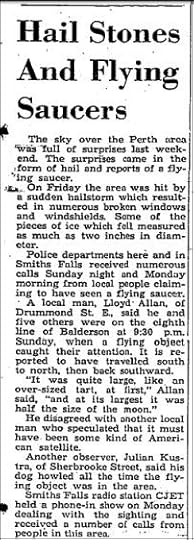

The next UFO sighting to be reported in the fall of 1973 took place in Beckwith Township. A young man was returning to Perth from Ottawa, driving along Highway 7 near Carleton Place, when his headlights suddenly went out. Concerned that he might be pulled over by the police with his headlights out he decided to take the back way, and turned onto Tennyson Road. The section of the road closest to Perth has swamp on both sides, and the lad noticed two large lights in the sky, hovering over the swamp. The object was in the sky just above the tree line. He pulled the car over to the side of the road, and as he stopped the car he noticed that the object stopped as well, and hovered over the swamp. He remained parked for a few minutes, and then started to drive again. When he began to move, so did the object, and it travelled parallel to him for a few more minutes, then disappeared. Early the next morning, when he pulled out of his driveway in Perth, his headlights were working again.

Another sighting in the late summer of 1973 was first reported by a young lad working at a gas station in Smiths Falls. He spotted a small sphere in the sky that appeared to be hovering in one fixed location. He reported seeing silver flames coming from both the top and the bottom of the craft. The lad was quick to call CJET radio station, and ask if anyone else had seen the odd sphere in the sky. The radio station confirmed that yes, indeed; they could see it as well. In the days that followed, at least 40 people in the Smiths Falls area came forward, stating that they had seen the object as well.
…and in the Ottawa area in 1973:
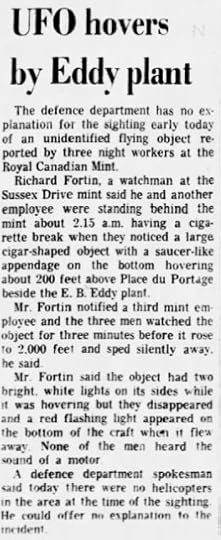
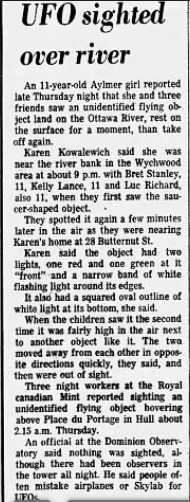
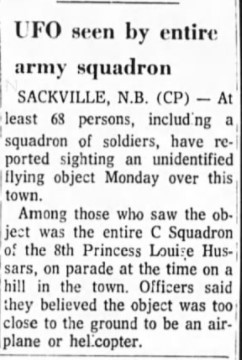
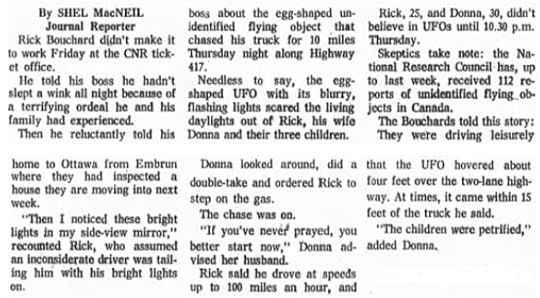
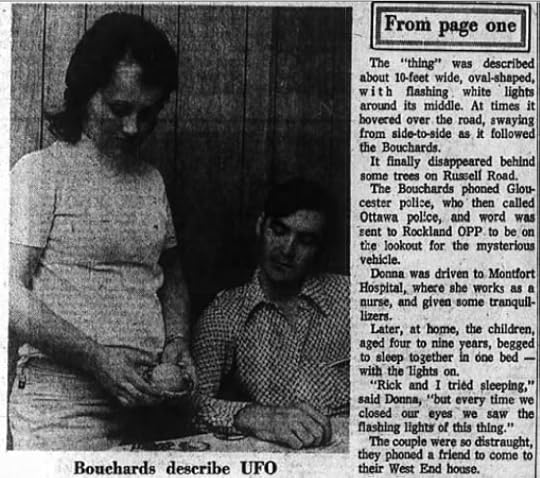 “The Ottawa Journal”, Nov. 10, 1973, p. 1 & 2
“The Ottawa Journal”, Nov. 10, 1973, p. 1 & 2

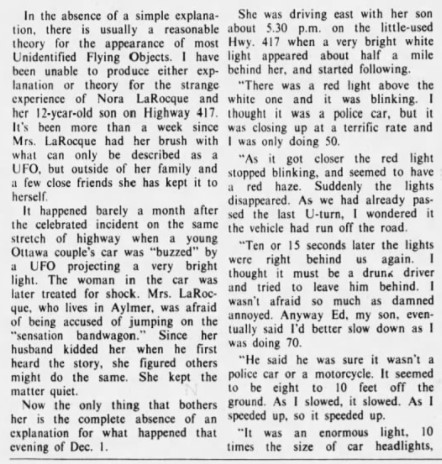
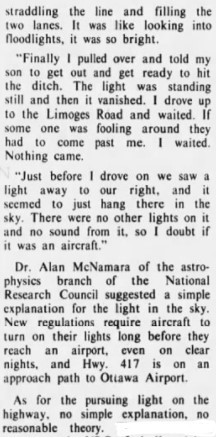
In the summer of 1974 people were once again talking about another strange object in the sky. It was a typical warm summer evening on the Rideau Lakes, and there were cottagers and residents alike, who saw more than they bargained for, on the night of August 12th. At around 10 p.m., many were sitting outside, enjoying the call of the loons, and listening to the water lapping on the shore. Suddenly, high in the night sky, a cigar-shaped object appeared. Some described it as a long, flat shape, orange in colour. Many said that it was more red than orange, and was shaped like a sphere. Everyone that saw it agreed that it was silent, and it hovered over the Big Rideau Lake, on the south side of Horseshoe Bay, for several minutes, and then vanished.

It wasn’t just in the Perth area that strange objects and lights appeared in the sky. Several residents of the town of Brockville, including some local police officers, confirmed the sightings of some odd lights moving in the night skies.

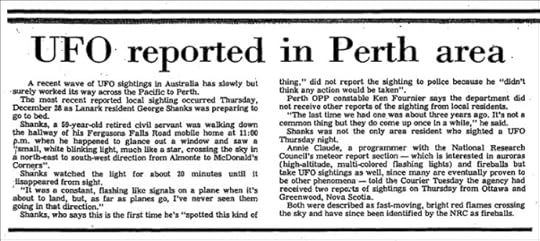
Strange sightings of unidentified flying objects were recorded in the Perth area as early as the late 1950s. Fiery balls of light, objects moving up and down, back and forth, quickly, in ways that airplanes were not able to maneuver.
UFO Tracking StationEstablished near OttawaUFO tracking stations were established just outside of Ottawa, and rumours of government radio towers and underground facilities were heard up and down the concessions in Lanark County. Excavations were reported near Almonte, and government agents were testing the soil on several farms in Ramsay Township.
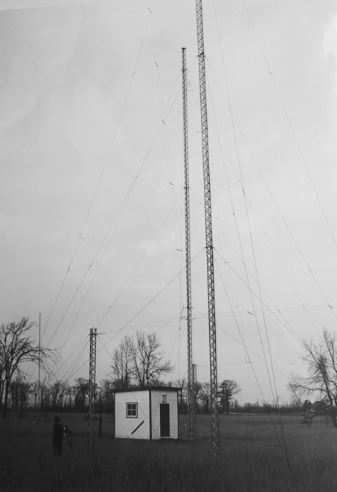
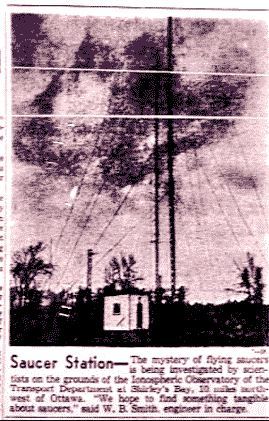
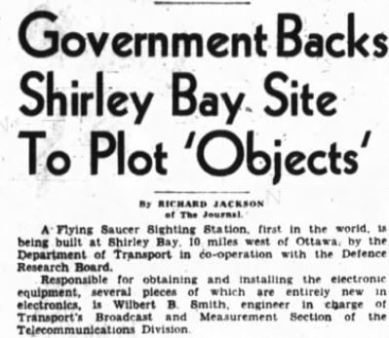
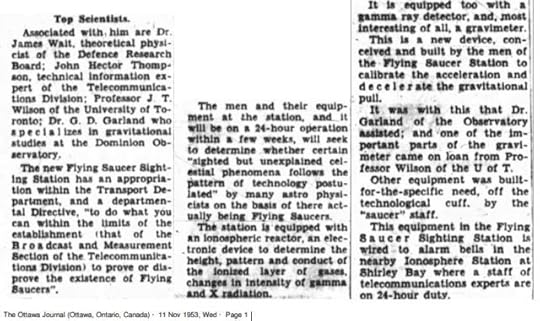
When reporters attempted to investigate further, the government representatives denied all, despite the fact that local men were working as labourers on many of the projects and could confirm what they had seen.
“On August 8, 1954, Smith, and his team at Shirley’s Bay recorded a disturbance, they believed was caused by a UFO. Among the observations that day were transmissions being received too rapid for a trained operator to decipher.”
December 26, 2018, ‘The Ottawa Citizen’ p. A6Just days later, ‘Project Magnet’, as it was known, was disbanded, without explanation.
For more information on strange sightings in the night skies over Lanark County, and the government’s classified projects in the 1960s and 1970s, read the full story ‘Perplexed in Perth’, from “Lanark County Classics: A Treasury of Tales from Another Time”, ISBN 978-0-9877026-54
Available at local bookstores, or online
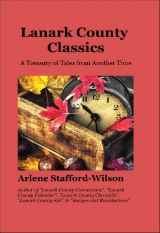
Arlene Stafford-Wilson
Member, Association of Professional GenealogistsMember, Lanark County Genealogical SocietyAuthor of 10 books: “Lanark County Christmas”, “Lanark County Comfort”, “Lanark County Collection”, “Lanark County Calling”, “Lanark County Classics”, “Lanark County Connections”, “Lanark County Calendar”, “Lanark County Chronicle”, “Lanark County Kid”, & “Recipes & Recollections”available at local stores or email: lanarkcountybooks@gmail.com




